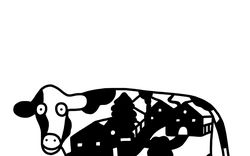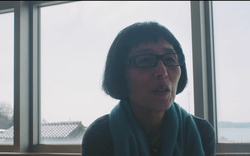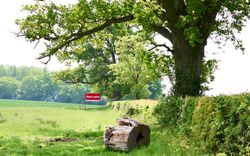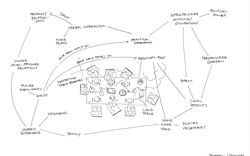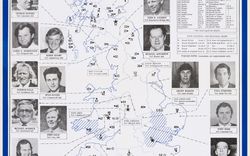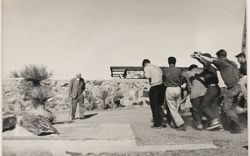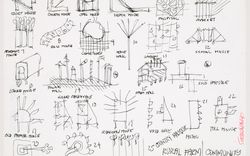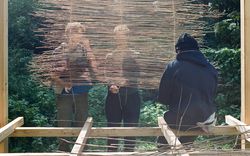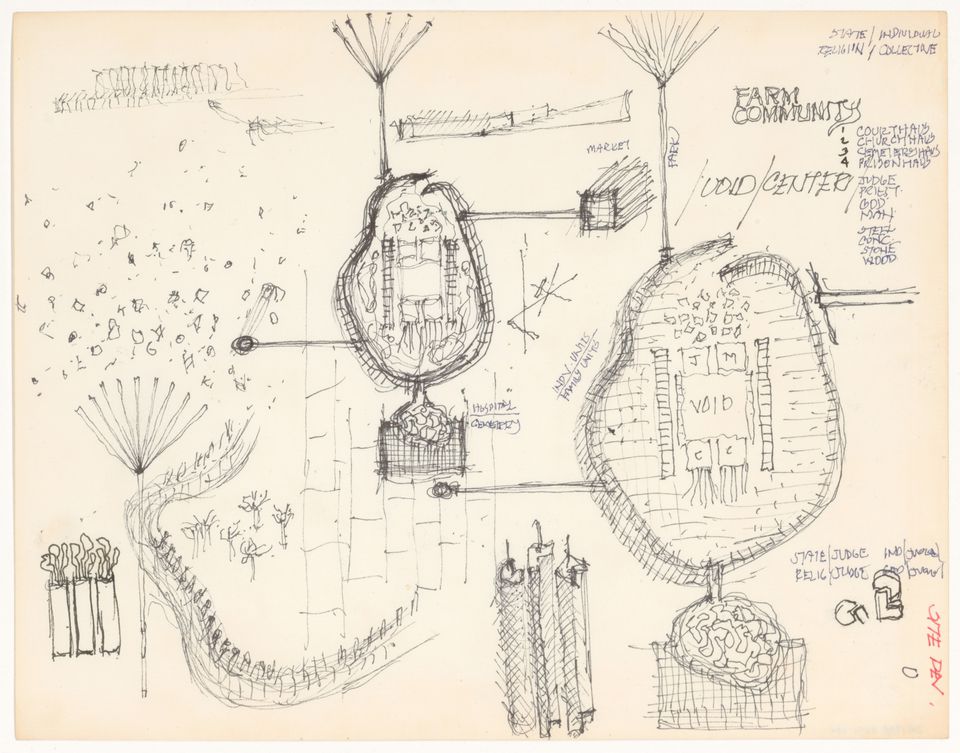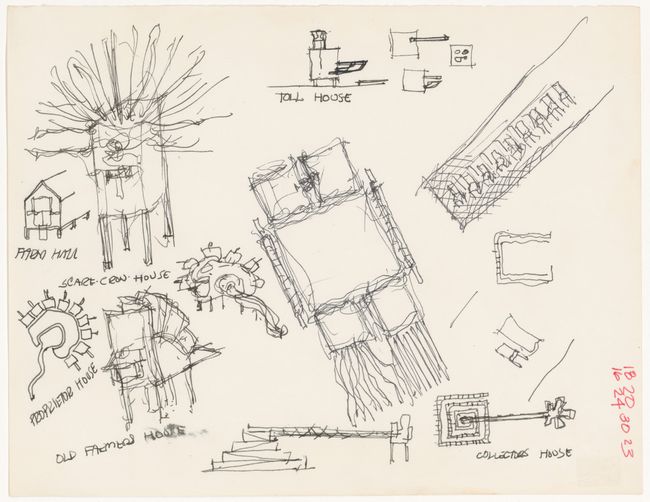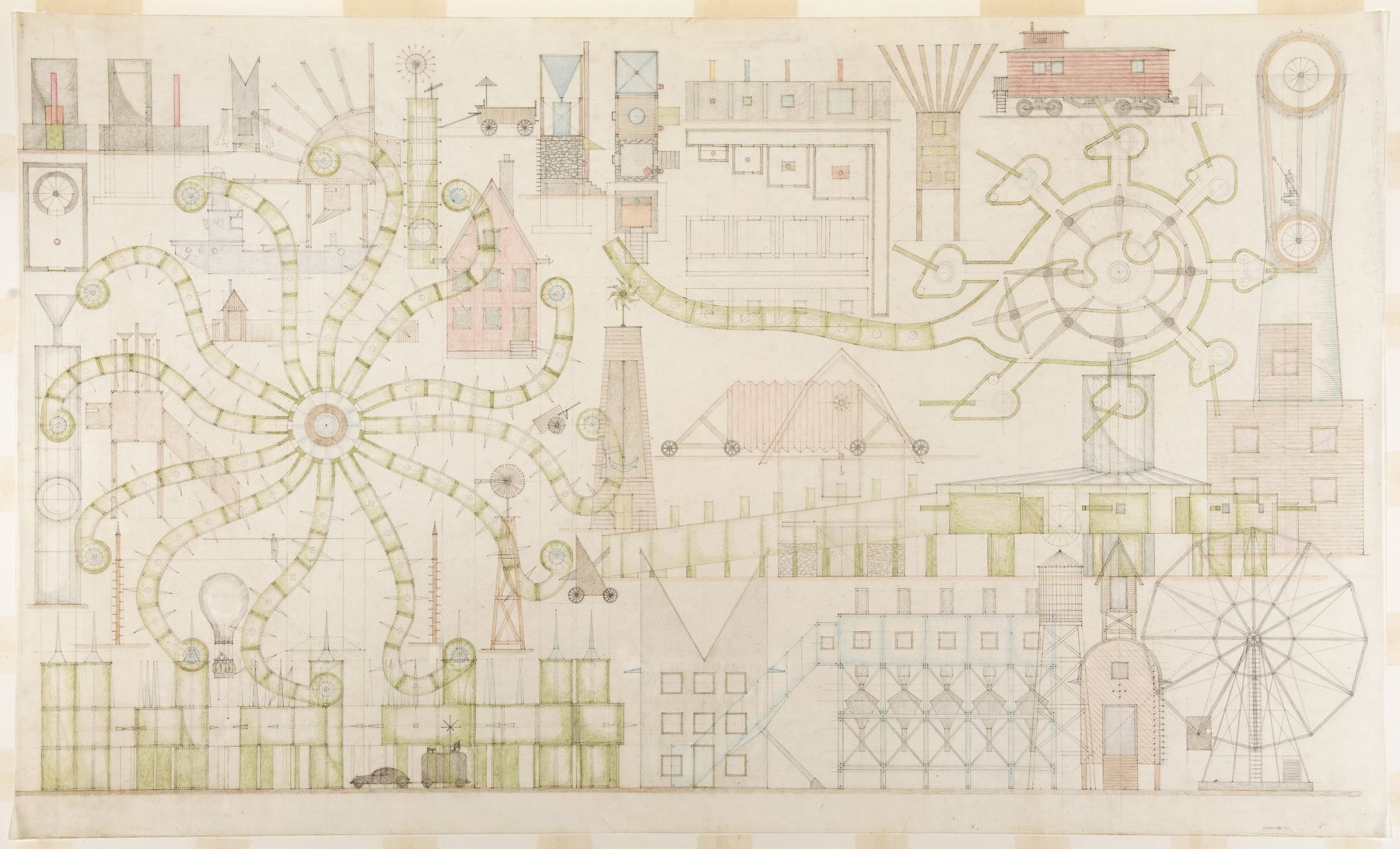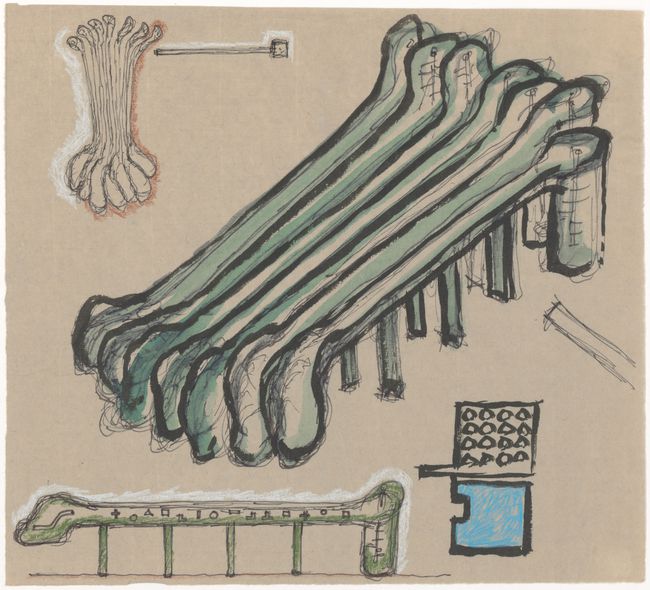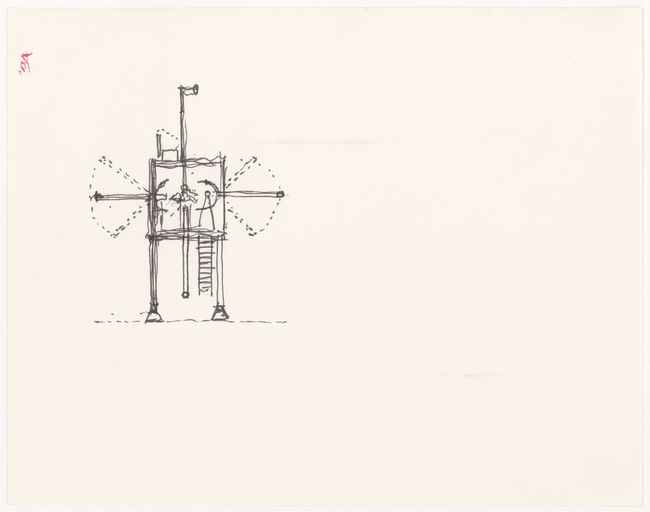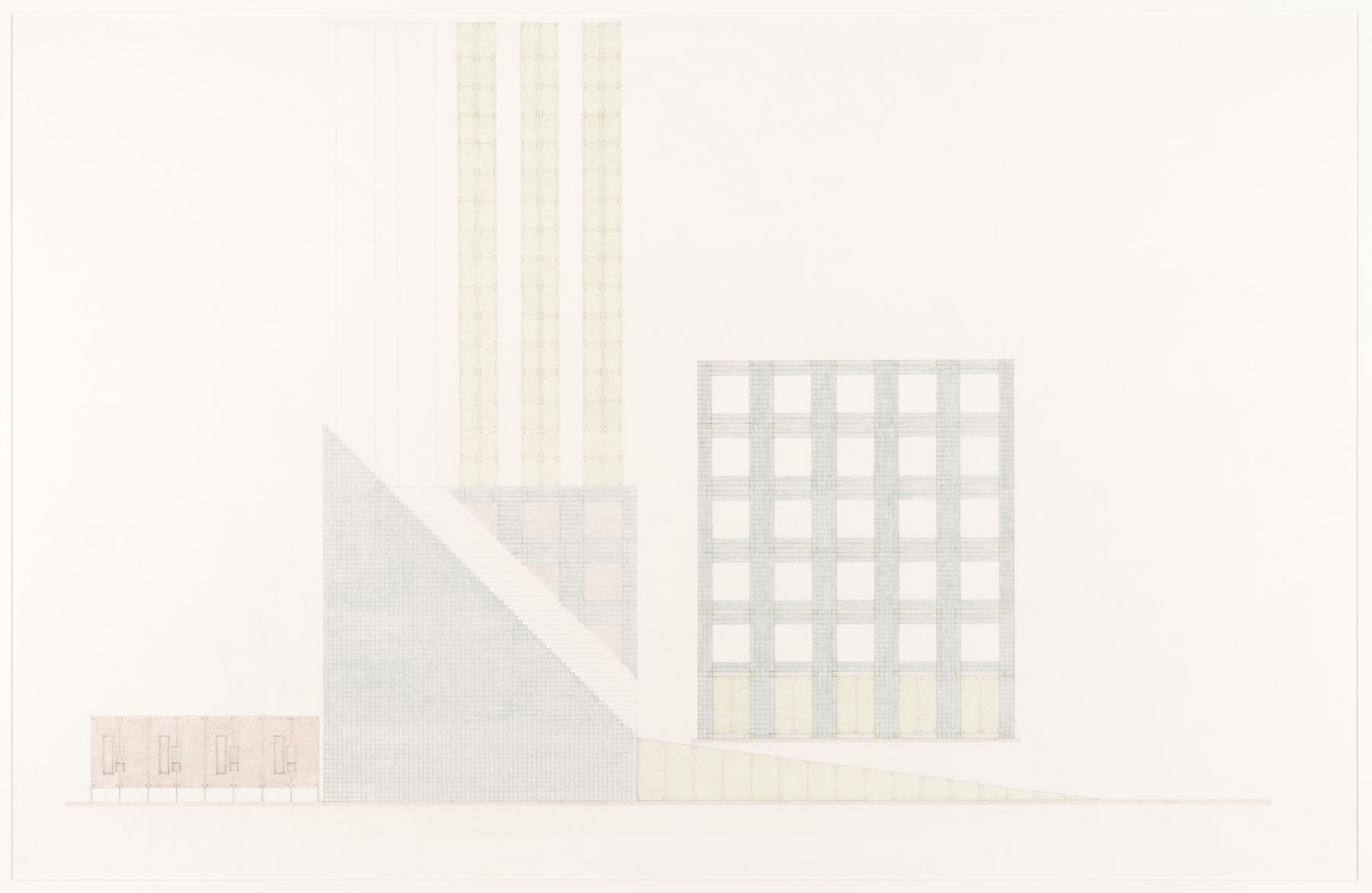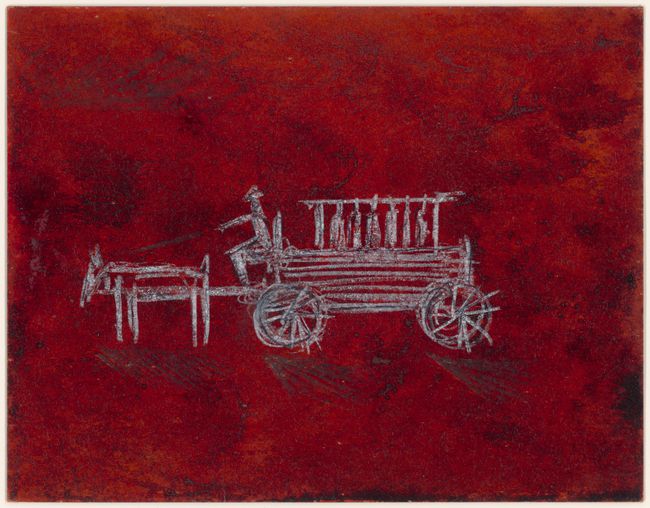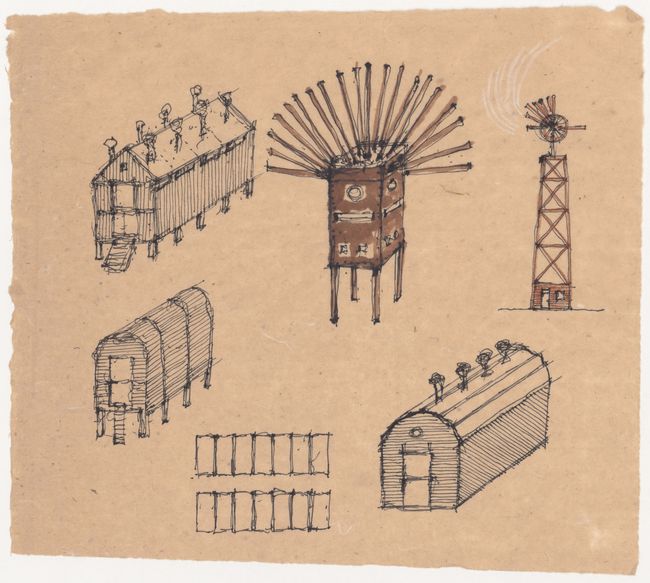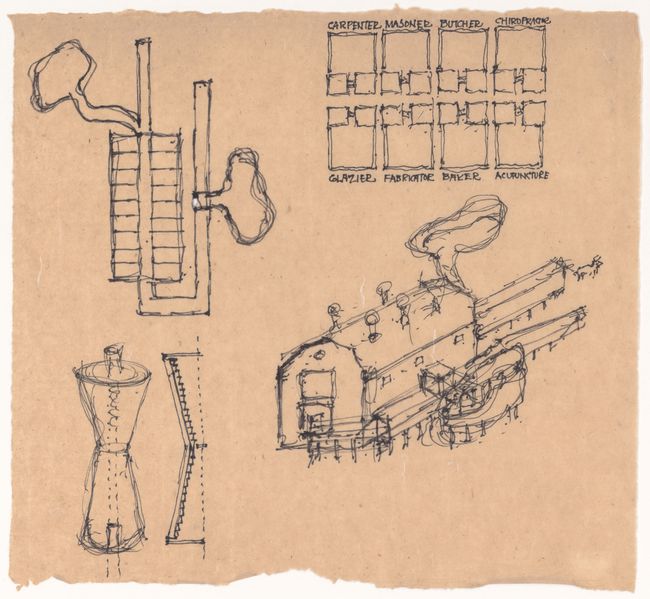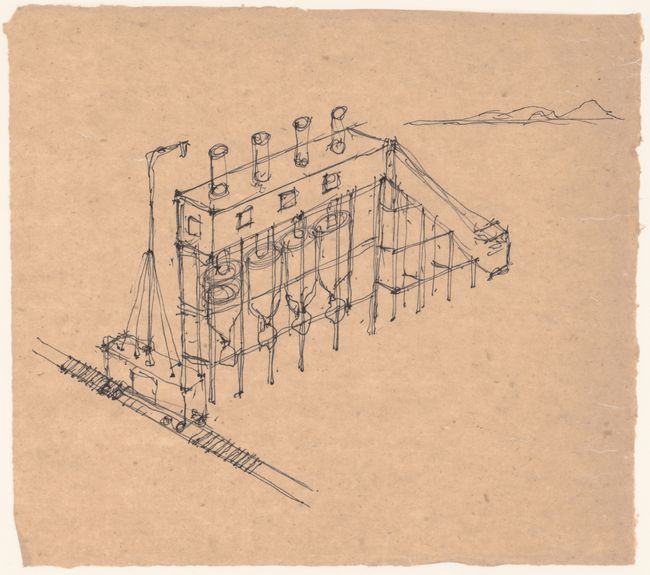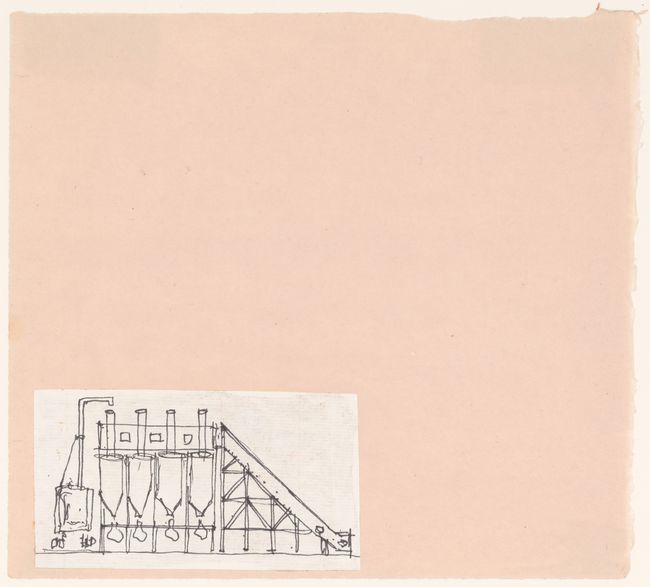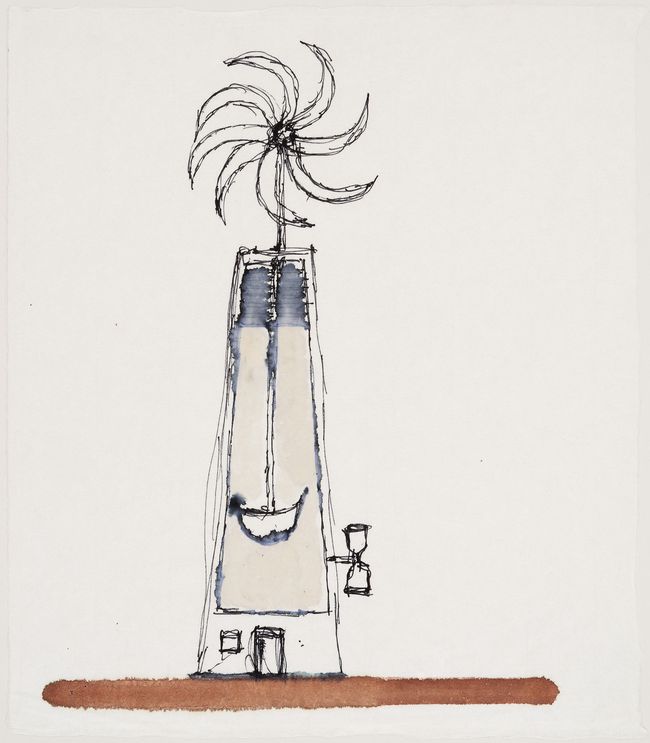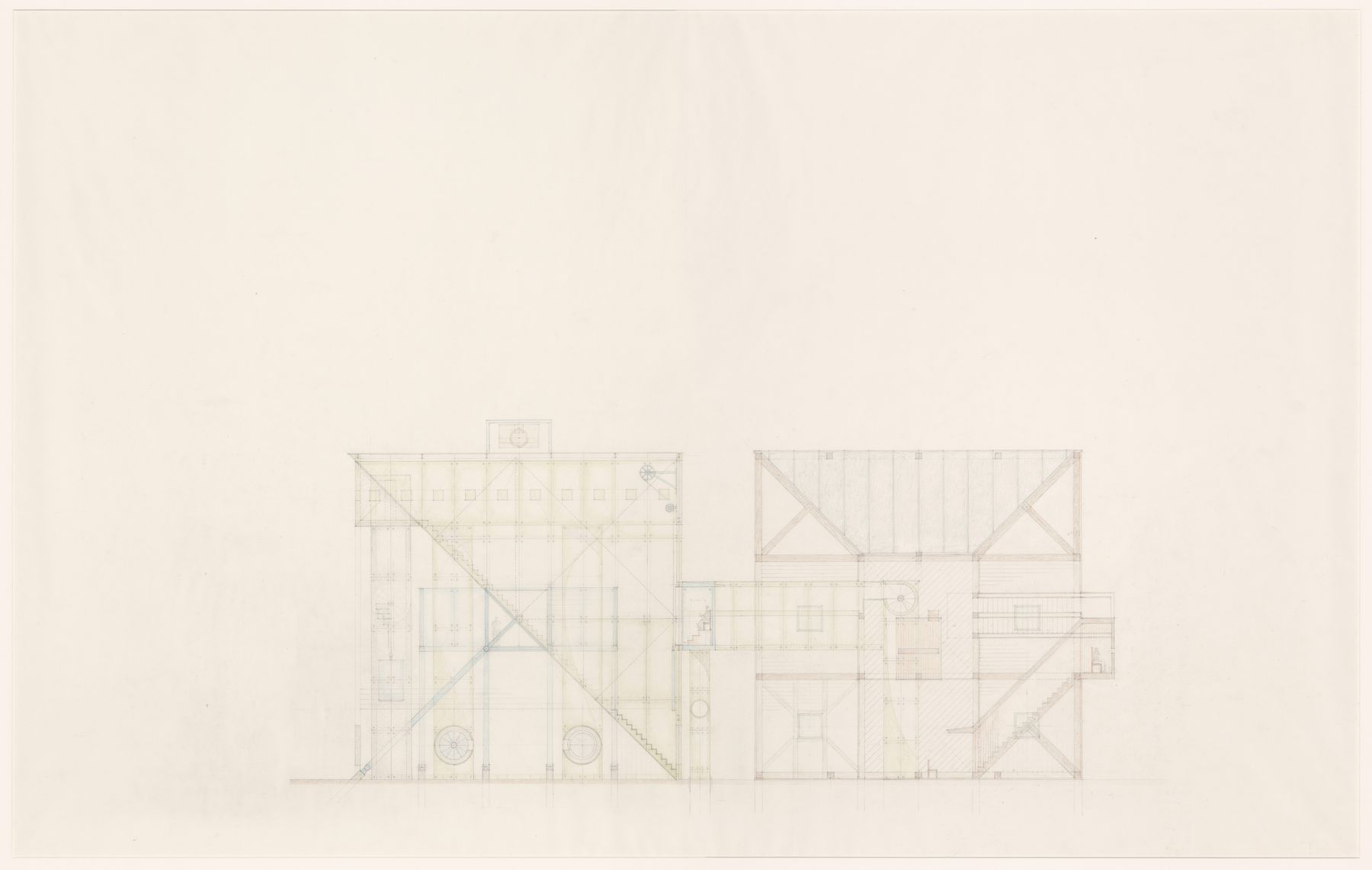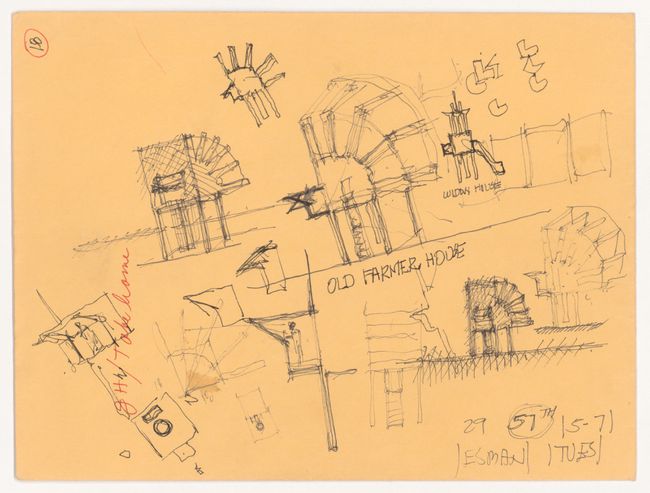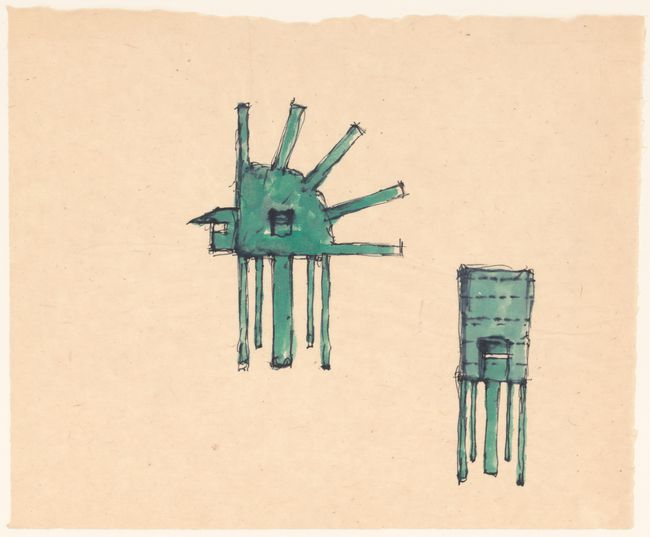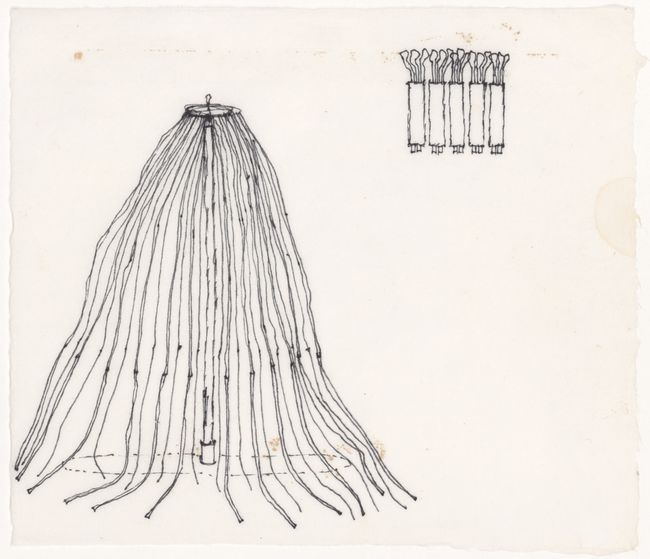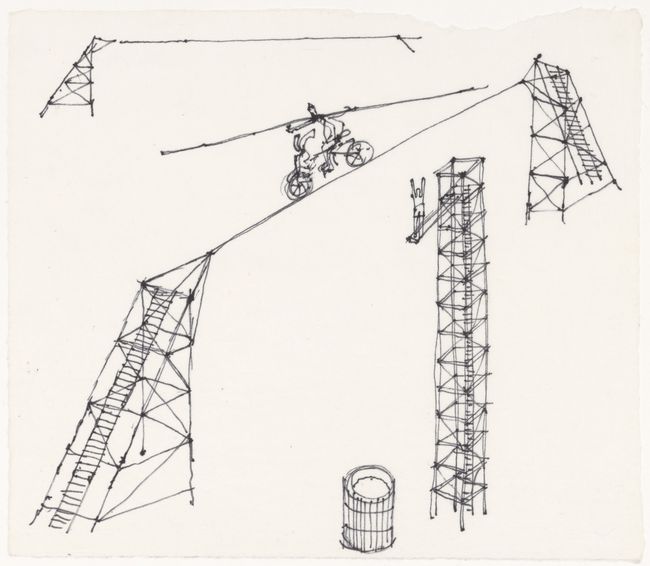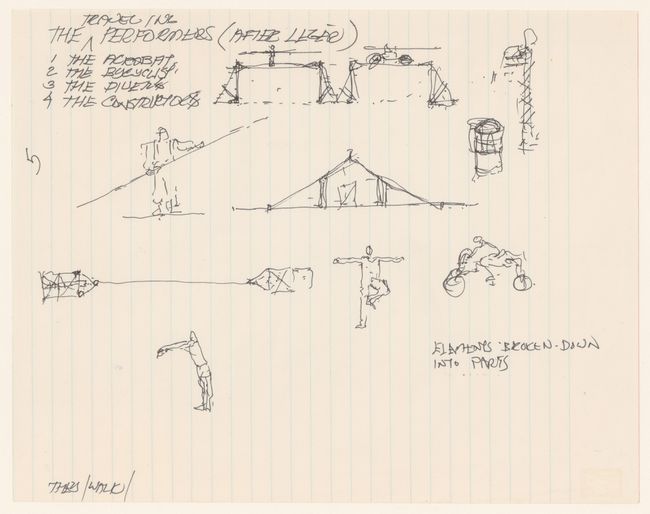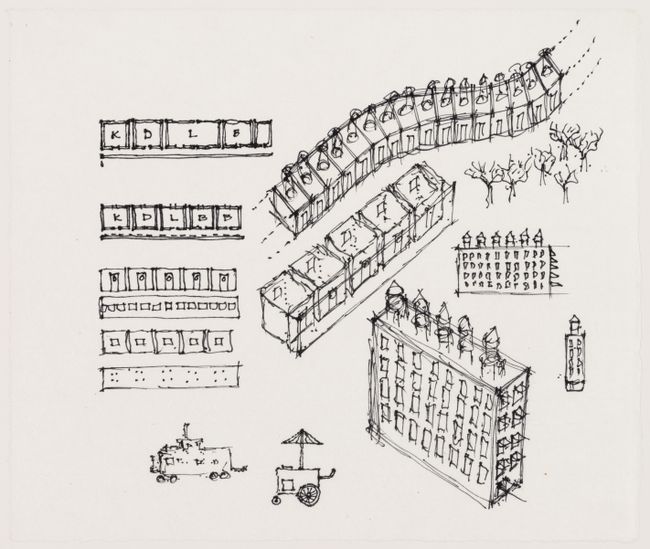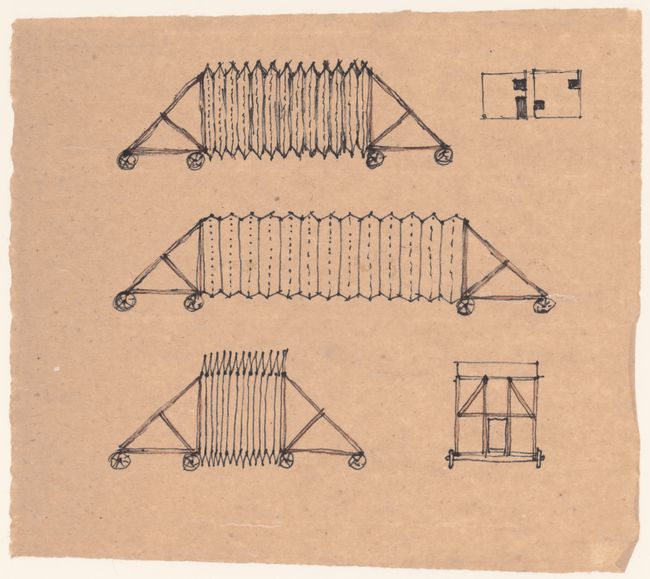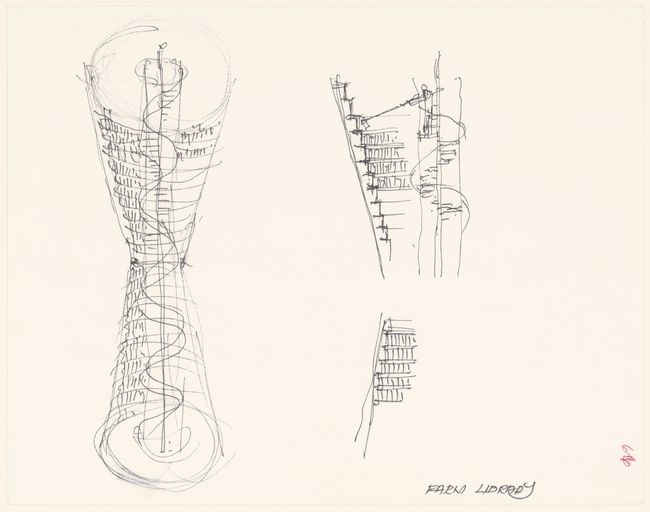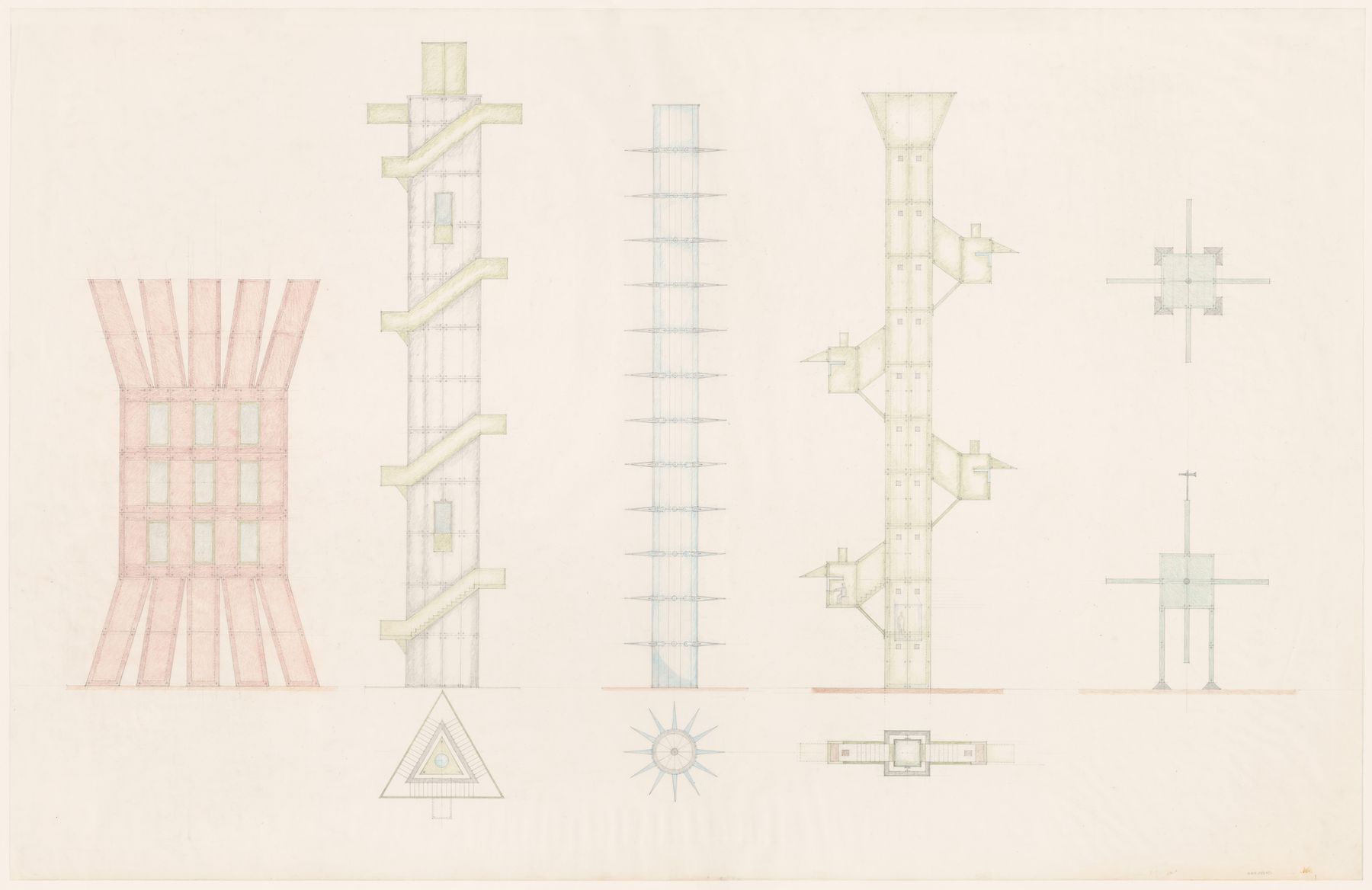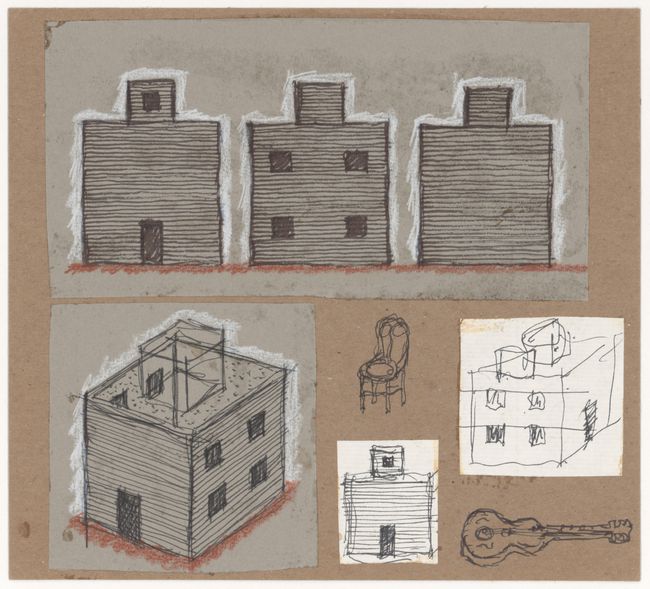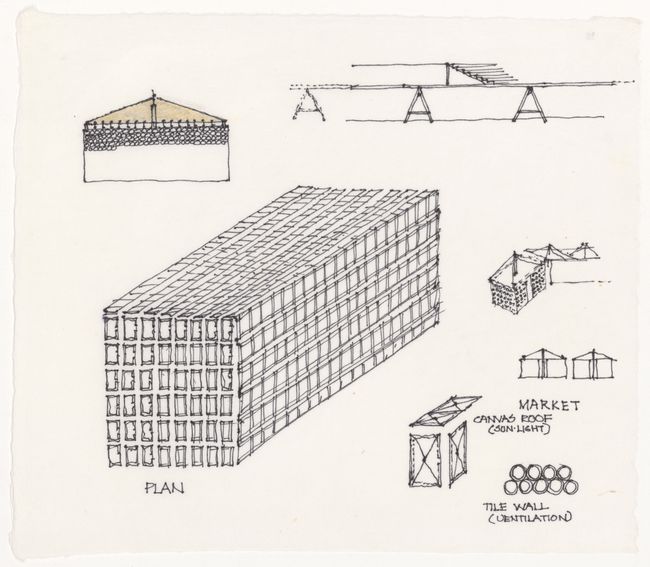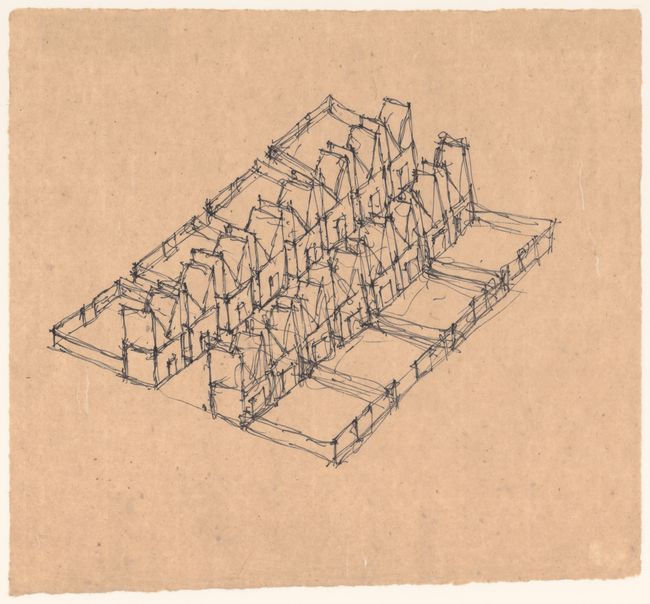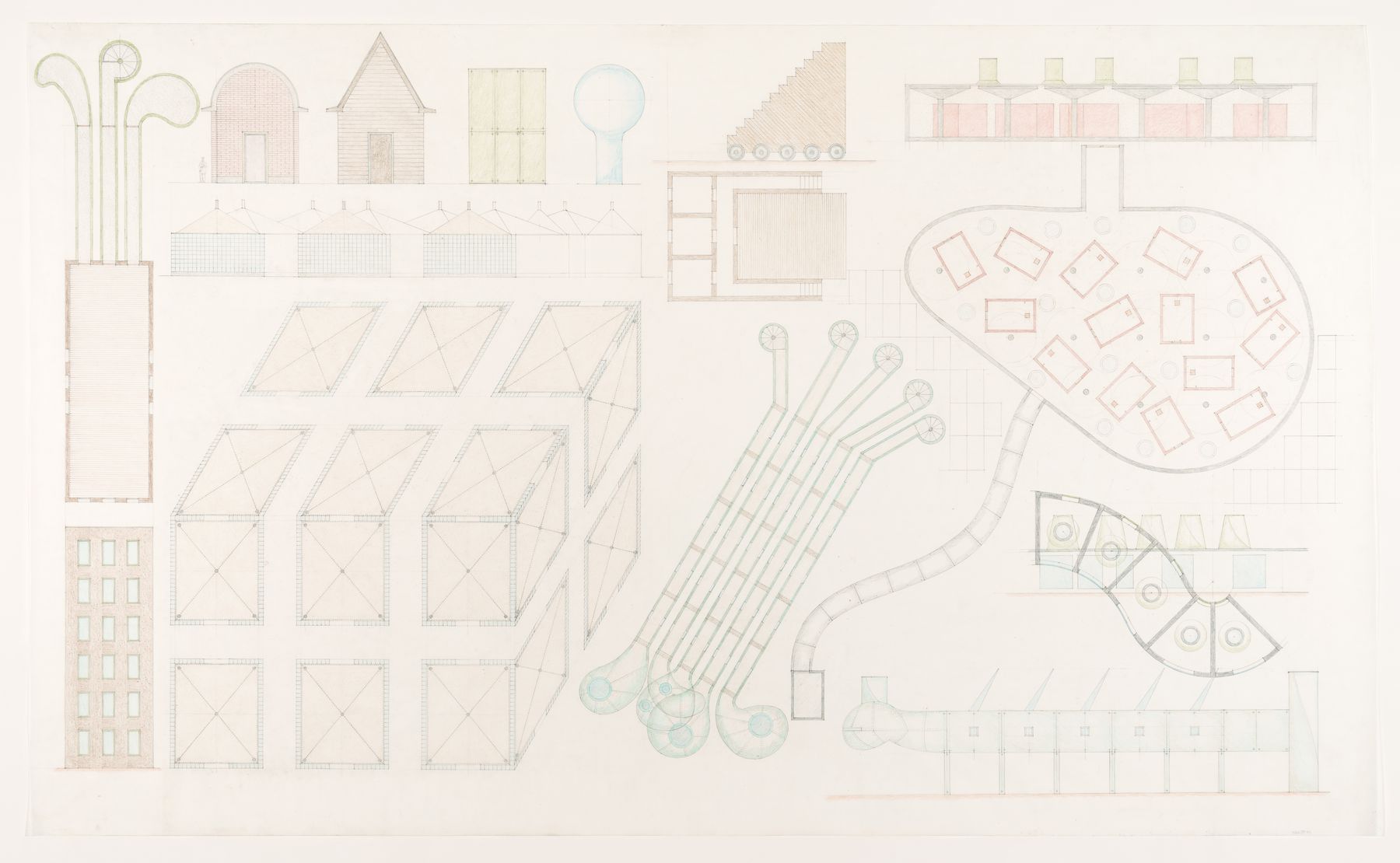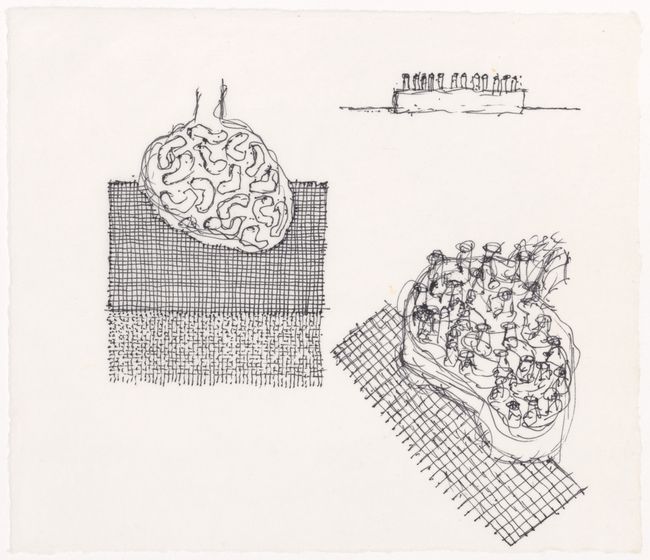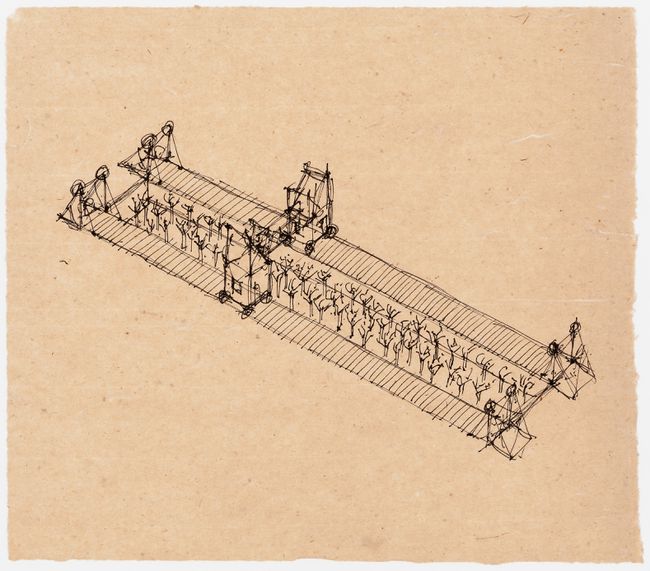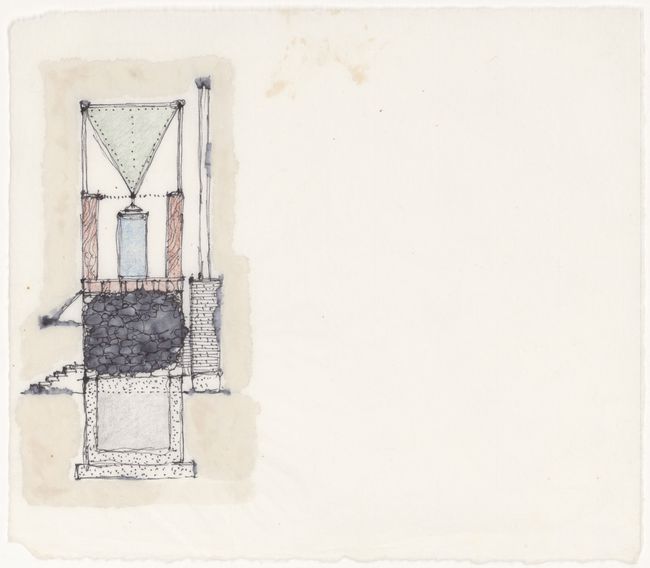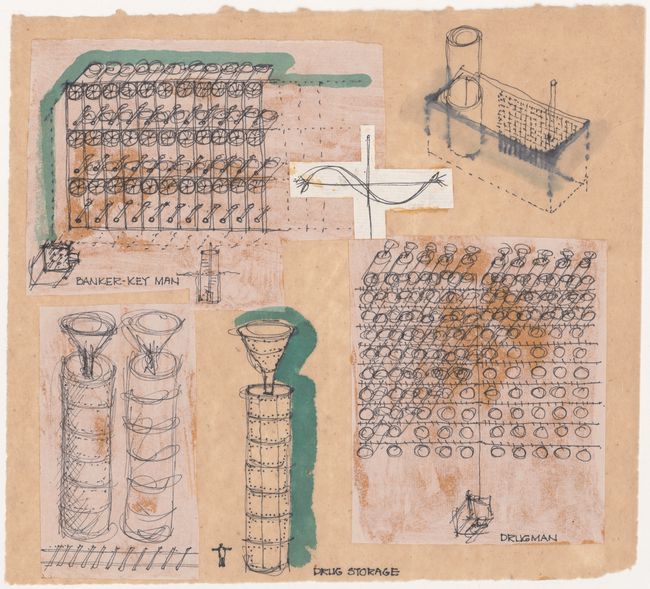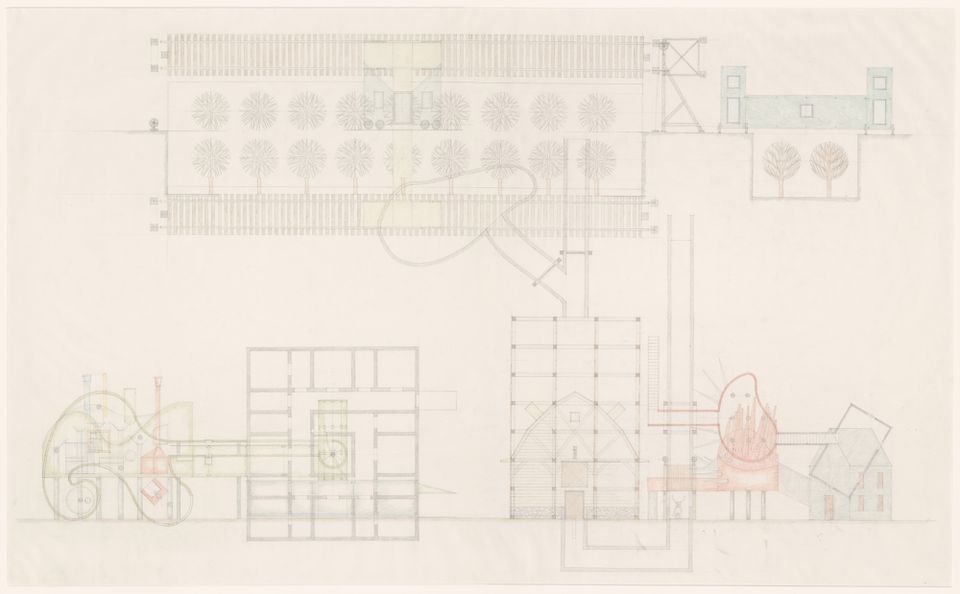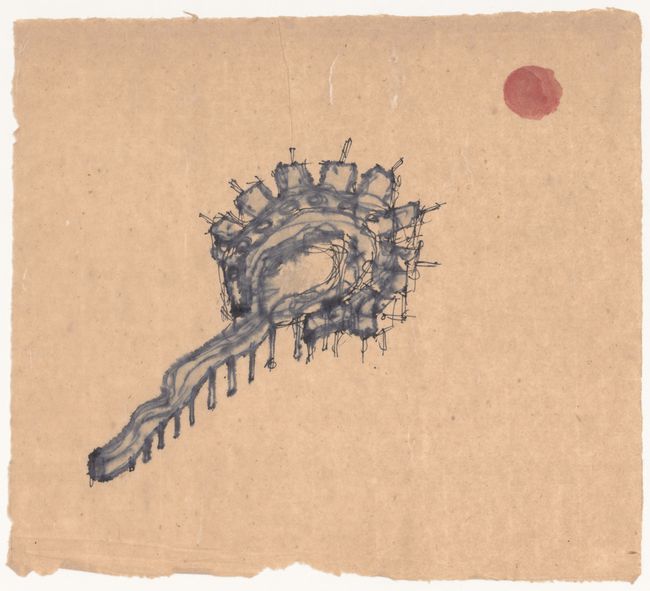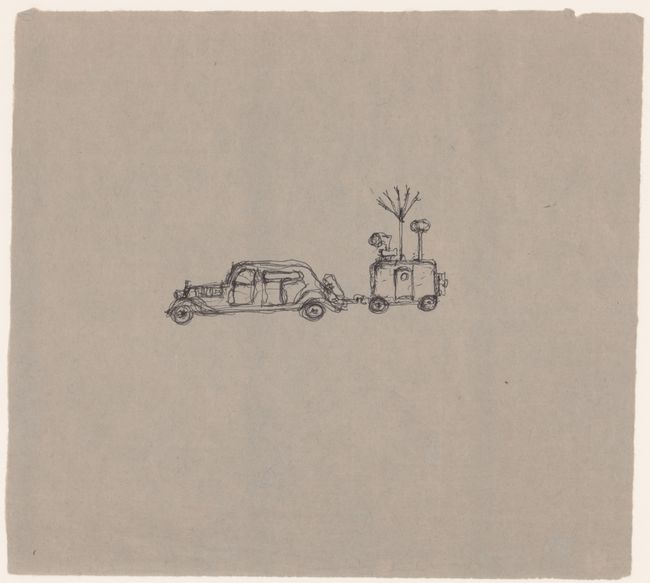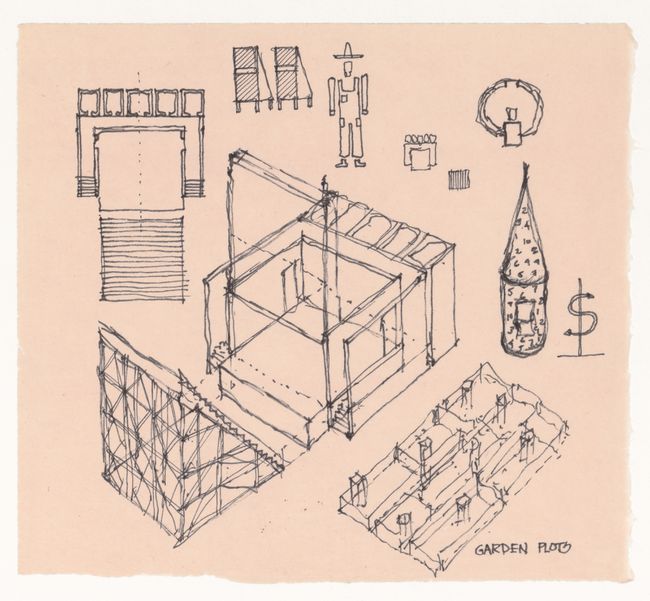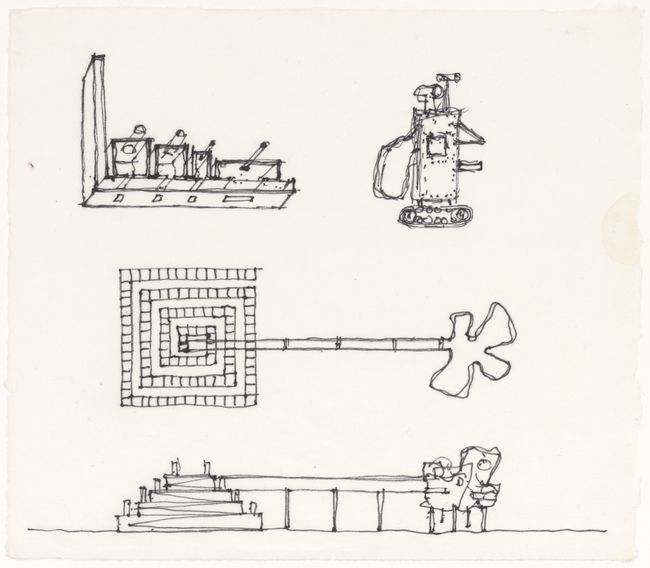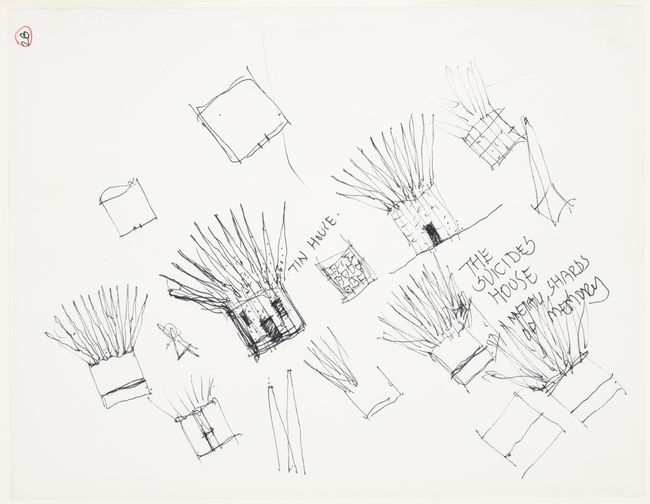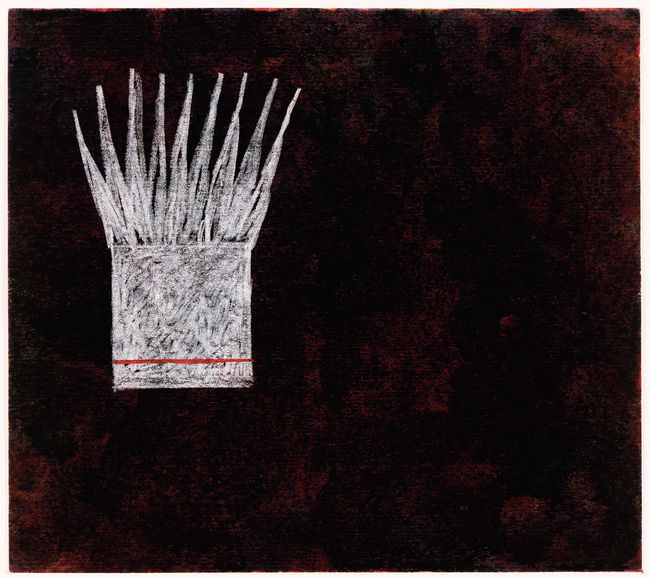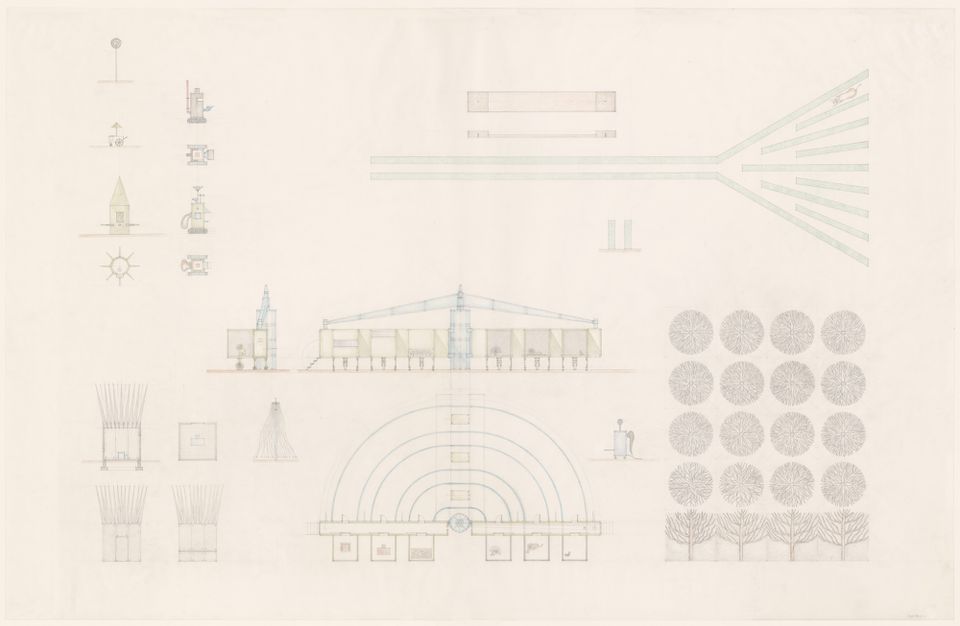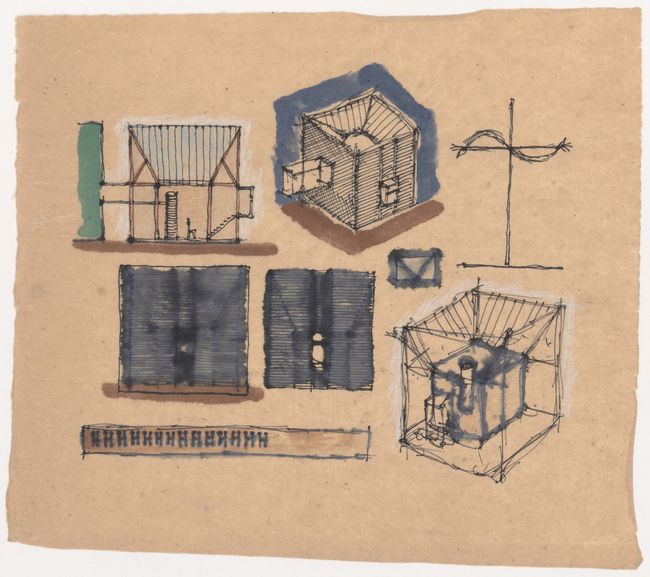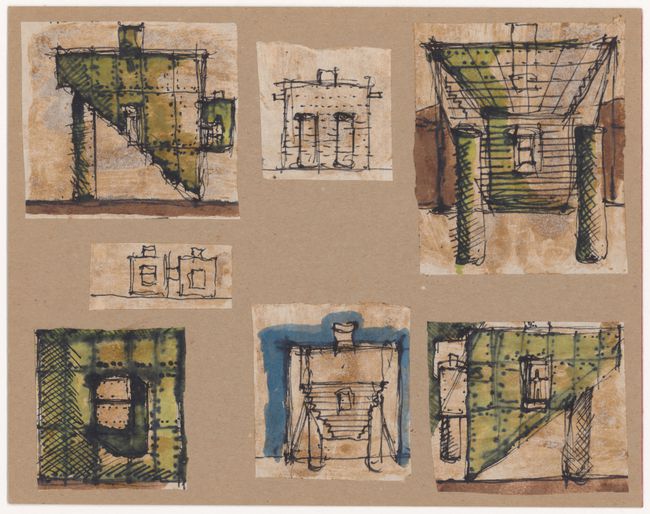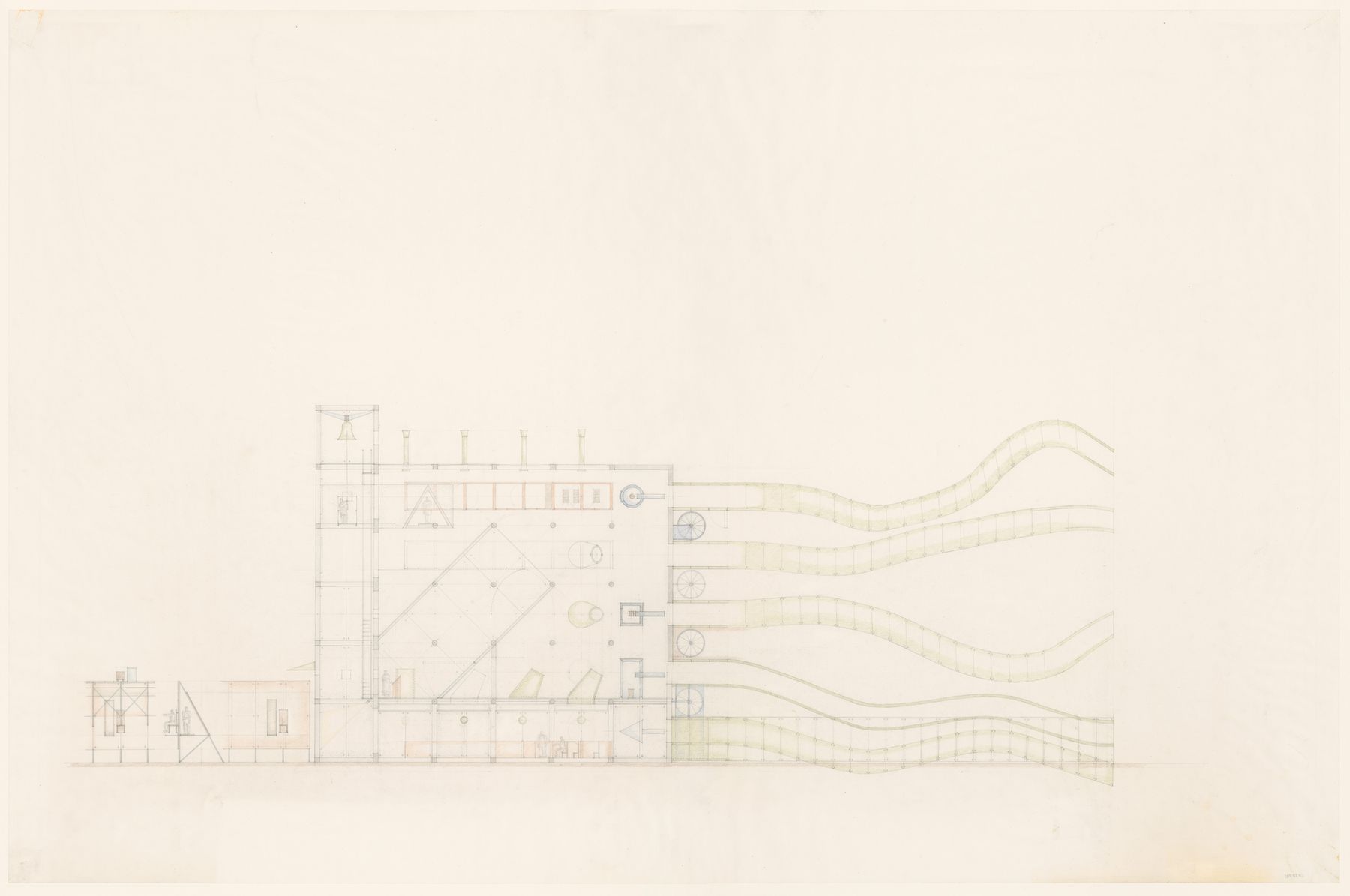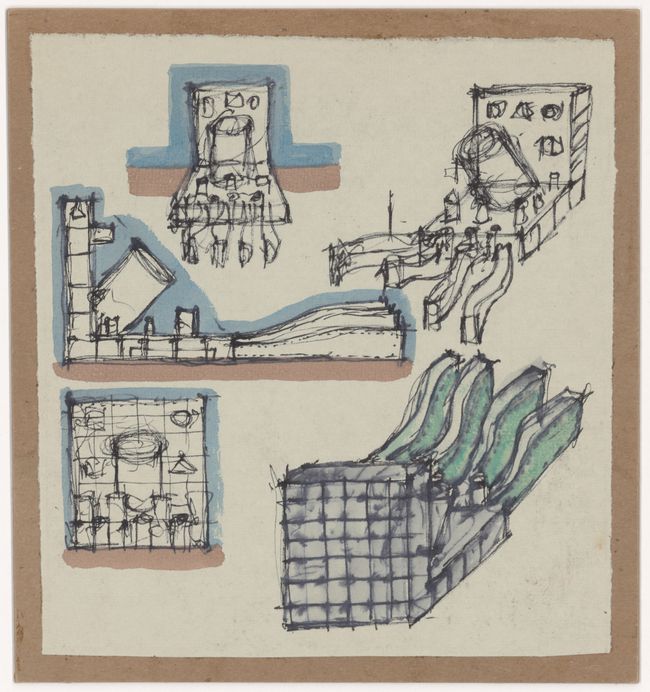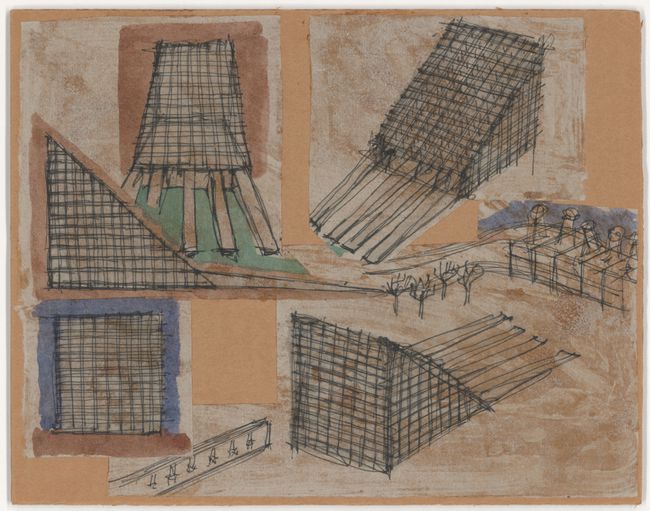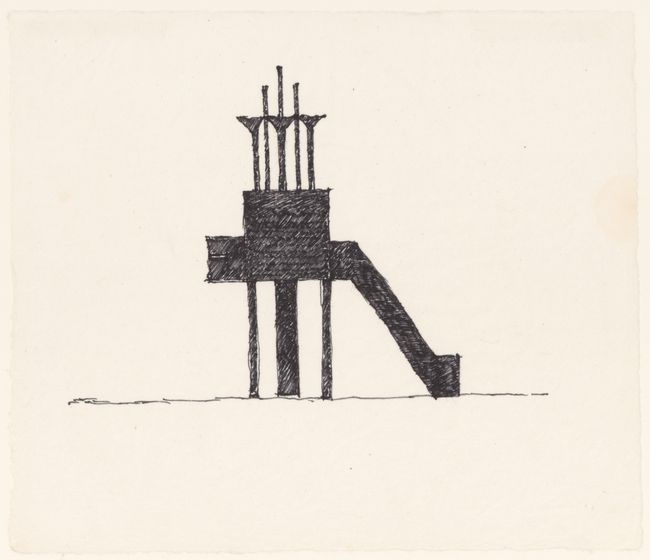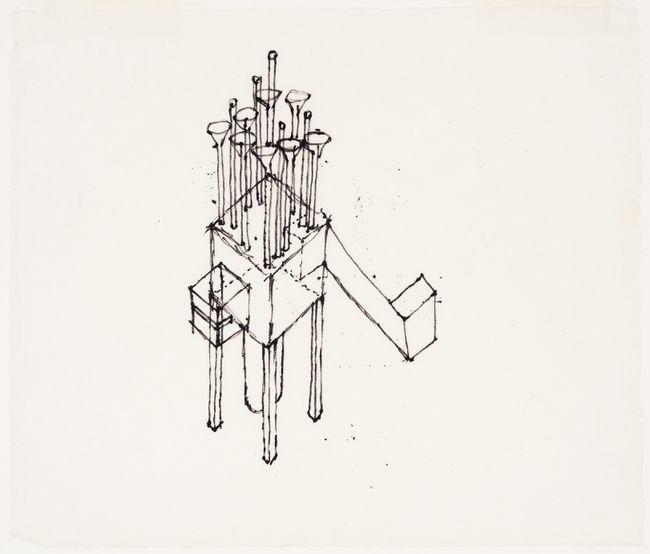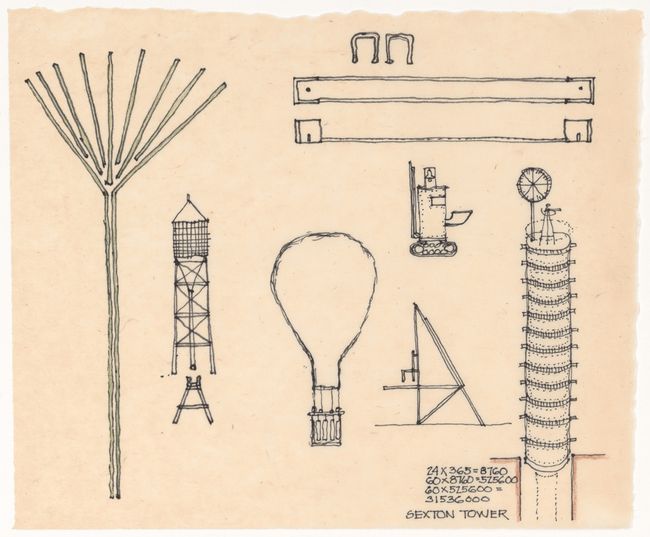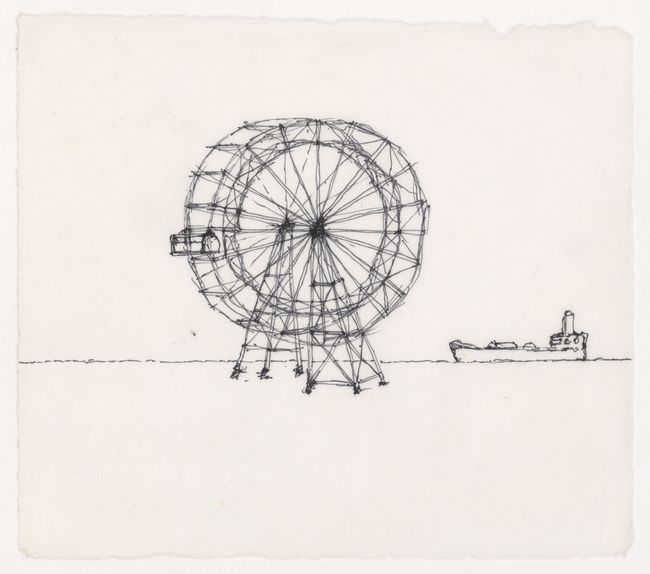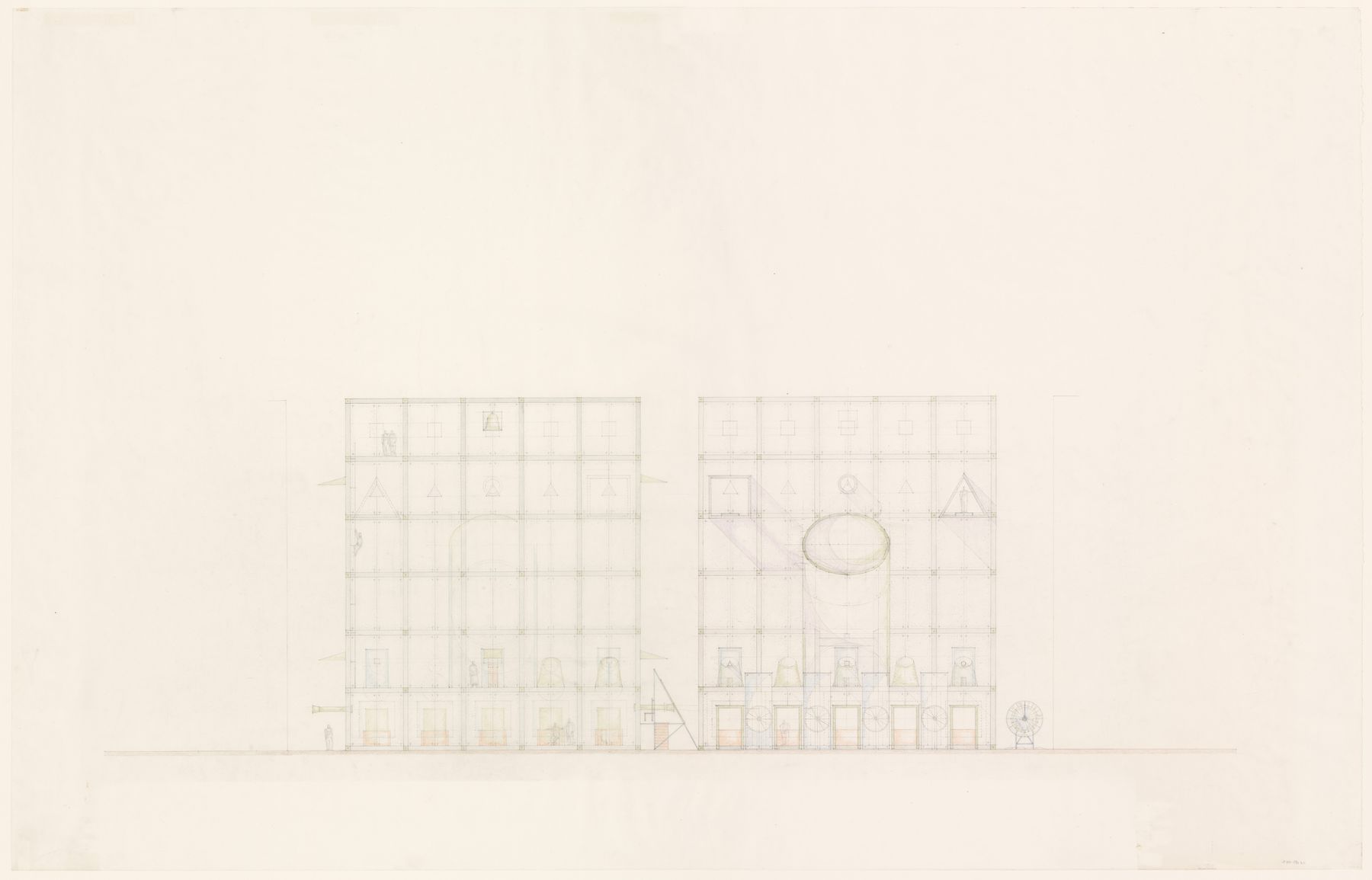The Lancaster/Hanover Masque
A project by John Hejduk
OBJECT
SUBJECT
6:30 a.m. to 6:30 p.m.
1 The caboose is hooked up to the freight train
6:30 a.m. to 6:30 p.m.
The Summer Visitor holds up her mirror
2 The bilges of the barge are opened
The Bargeman pulls in the rope
3 The Hotel awnings are lowered
The Transient sits on the edge of the bed
4 The wind begins to blow on Tower Hill
The Sentinels watch
5 The telescope zooms in on its subject
The Retired General adjusts his field glasses
6 The curtain is raised
The Retired Actor applies the mascara
7 The barometer remains steady at 29.05
The Weatherman begins to perspire
8 The Sexton receives the oil
The Surveyor puts on his tan knickers
9 The Farm Land is covered in snow
The Farmers hum
10 The trees are protected
The Community curses
11 The garden tool sheds are locked
The Gardeners plant
12 The old clothes wagon is pulled out of the barn
The Old Clothes Man searches in his bag
13 The scare-crow’s hat is adjusted
The Keeper of Scare Crows ties the straw
14 A horse fly bites the arse of a cow
The Farm Animals stir
15 A needle is placed into the horse’s neck
The Veterinarian sleepwalks
16 The porch is covered in red dust
The Reddleman dusts off his sleeve
17 The silos are empty
The People sleep
18 The Store House is full
The Preserver checks the lists
19 The burlap bags bulge with seed
The Sower grasps his fallen seed
20 The blade is removed
The Reaper sharpens the blade
21 The steel deflects
The Old Farmer remembers
22 The hedges are cut
The Elders are filled with jealousy
23 The spike is driven
The Players measure the distance
24 The streamers hang
The Children cut their soles
25 The bicycle is repaired
The Travelling Performers stretch the wire
27 The vents are closed
The Workers complain
28 The boiler room is silent
The Dwellers dwell
29 The School House is lonely on Sundays
The Students sing a song
30 The book bleeds in leather bindings
The Librarian mends a binding
31 Sounds emit from double-hung windows
The Cellist fingers
32 Damaged vegetables are placed in wood crates
The Merchant scratches
A32 Sweet when chilled in ice
The Butterwoman churns the butter
33 The “A” Frame is waxed
The Carpenter builds a frame
34 A thousand-legger crawls over the bricks
The Mason looks for his trowel
35 Suction-rubbers separate the glass
The Glazier cracks the glass
36 Lies are sealed
The Fabricator fabricates
37 Joints are soldered
The Repairman solders the joints
38 Needles are placed in leather
The Chiropractor/Acupuncturist yawns
39 Fat boils in the vat
The Butcher plucks a chicken
40 Ovens fired
The Baker kneads
41 Butterflies exhibited
The Citizens vote
42 Ticket-tape shut
The Toll-Taker smokes a cigarette
43 Blood bank full
The Physician injects
44 Quiet
The Undertaker contracts
45 Flood lights lit
All
46 Suspended
The Convert thinks of the other side
47 Filled with wood stools
The Transfers wait
48 Nordic porcelain
The Master Builder washes his teeth
49 Pipes flushed
The Druggist hides the evidence
50 Maintained by vacuum cleaners
The Bank-Key Man grinds a key
51 Interiors painted green
The Proprietor sucks an egg
52 In constant motion
The Farm Manager broods
53 Guaranteed licence
The Observers make a sign
54 Bull’s eye replaced every fortnight
The Inspector replaces his revolver
55 Zoological implications
The Trapper springs the trap
56 Taped arguments
The Lawyer writes the brief
57 1 to 10
The Accountant snaps his pencil
58 Hollow guilt
The Useless peer into the rooms
59 Ordered interned
The Suicide makes a mistake
60 Greek origin
The Collector wipes the frame
61 Wood
The Accused capitulates
62 Steel
The Judge reads the sentence
63 Concrete
The Priest confesses
64 Stone
The Dead
65 Funnels constructed by Trombone-Maker
The Widow wails
66 Function depends on air
The Balloonist lights the flame-thrower
67 Dust
The Void remains silent
68 Time/Still-Life/Nature morte
The Keeper of the Time fears a delay
OBJECT
1. Summer Visitor’s Place
A red caboose.
Fabricated in St Louis, 1923.
SUBJECT
The Summer Visitor
She arrives by rail and is housed in the caboose car of a freight train. The freight train disposes its cargo onto the barge owned by the Bargeman. During the unloading the caboose is unhooked and left at a siding where it remains during the summer months, June-July-August. The caboose on the siding runs parallel to the canal and parallel to the barge. Once a year the caboose is painted train red, slightly lighter than barn red. Metal fittings are painted black. All in all, the caboose is a very pleasant place to live for a summer. A bouquet of farm flowers is delivered every morning to the Summer Visitor along with the daily schedule of the route of the Farm Manager. The Summer Visitor’s main study is Cézanne’s painting, The House of the Hanged Man, sometimes called The House of the Suicide. On Tuesday evenings she invites the Farm Manager and the Fabricator to play cards under the lamp of the caboose. She is a good friend of the Time-Keeper. She has always admired his invention of dual-time.
2. Bargeman’s Place
Amsterdam Barge.
Receives goods from freight train.
Plies the canal.
Unloads train goods.
Receives farm products from freight train.
The Bargeman’s journey takes 28 days round-trip.
The Barge canal is a straight run point to point.
The Bargeman takes transfers to points of destination.
The Bargeman lives with his wife whose face reminds him of distant places.
The Bargeman
He became fascinated with Puccini’s Il Tabaro. It always made him sad. He travelled by foot until he found a straight canal that measured 28 days point to point. The problem was how to make a 360° turn. His mistress lived at the Music House. He treasured a print given him in Antwerp. It pictured a black sea gull flying in between the stripes of green and brown wall paper. A French painter made the work. He could not remember the name.
3. Hotel
Structure: based on a painting
by Edward Hopper.
The atmosphere could be found
in 1910 and in 1936
—only in America.
Awnings were an essential part
of the brick buildings’ structure.
For some reason little girls
with light brown knee socks
and black high shoes
were found playing
next to the Hotel
in an abandoned lot.
Rope skipping, jacks, tops
and marbles were used.
The fact of kidnapping struck
a sense of dread
into the local neighbourhoods.
Saint Mary’s Park was
a place to be avoided.
So were men with spats
and removable collars,
particularly the ones that wore
suspenders and waist belts
at the same time.
The Transients
They seek nightly quarters. They are tolerated. They are in slow-motion. They are equivalent to still-life. The Farm People debate at length whether the Transients should receive tickets or not.
4. Tower Hill
A hill outside the centre of the Farm Community. The City of Berlin has decided to let the option of building certain towers lapse. Consequently the towers are to be removed from Berlin to Tower Hill in the Lancaster/Hanover Masque. The towers are to be put under the jurisdiction and protection of the Retired General. The General is reported to take this new responsibility in dead earnest. The towers are the Wind Tower, the Watch Tower, the Bell Tower, the Clock Tower, the Water Tower and the Observation Tower. There are negotiations going on relative to the Guest Towers of Berlin. The situation remains ambiguous.
The Sentinels
Wind Tower
Watch Tower
Bell Tower
Clock Tower
Water Tower
Observation Tower
Guest Towers
5. Retired General’s Place
Recently moved to Tower Hill.
Structure: steel frame - steel clad.
Equipped with navy binoculars, telescope, periscope, opera glasses, earphones, sonar technology, removable ladder, fishing chair, army cot and telephone.
The Retired General
Formerly in charge of the map-making division. He was stationed in West Berlin, Germany. He actually supervised all interpolations of East Germany’s Berlin Wall. He believes Berlin to be the first Medieval City. The Retired General becomes nervously excited when the airplane makes the final approach into Tempelhof. He is writing a book on the empty lots of Berlin, and is interested in the survival of the Linden Trees. He attempts to visit Berlin in the winter time when the snow is on the ground. He hires a black Mercedes and drives through the streets of Berlin from midnight to dawn. The sense and sound of the rubber tyres over the new-fallen snow with the windshield wipers arching away the flakes; the deep perspectives of the avenues with the leafless charcoal tree trunks and the black-grey buildings give him pause. He tries to get a Mercedes with an all black interior. He enjoys sitting on the leather seat. He puts on his button-down gloves and hums a section from The Magic Flute.
6. Retired Actor’s Place
Outdoor stage-proscenium at 90° to outdoor step-seating. Retired Actor’s apartment behind Stagehouse.
The Retired Actor
Performs whenever he wishes. Can be seen at different hours. He prefers to act at dusk. He holds open house once a week on Wednesday. His voice is weak, therefore he is involved in learning pantomime. He looks forward to introducing the Travelling Performers. He thinks them acrobats. As a child he used to visit Léger, a friend of his father. He remembers Léger’s trousers. They looked like hammered metal and folded canvas. Léger and his father discussed Flaubert’s Salammbô. A woman named Fiorentino whispered to him that Flaubert invented black and white. He believed her.
7. Weather Station
Structure: the impression is one that it was seen somewhere in the wheatfields of the Midwest.
The Weather Man
Reports on the weather. Docs not attempt to forecast; he reports past weather and present weather. He lives on the premises of the Weather Station. He is in daily contact with the Balloonist.
8. Plot Division
Structure:
A Cosmological Tower
covered with signs.
Measurement: prime element.
The Sexton and the Surveyor
share its functions.
The Surveyor
Elected by the Farm Council. The Surveyor is required to measure the sub-divisions of the Farm Land from a fixed position which is at the top of the Cosmological Tower (Plot Division). He is accompanied by the Sexton (appointed position). The Surveyor is dependent upon the Balloonist. They constantly exchange information. The Surveyor wears contact lenses, khaki pants, knee socks, a white T-shirt and a pair of old Grand Rapids shoes. The Sexton reads Hawthorne: Zenobia’s death disturbs him. He is trying to understand The Minister’s Black Veil.
9. Farm Land
A cooperative supervised by the Farm Manager, surveyed by the Surveyor, policed by the Keeper of Scare-Crows, advised by the Old Farmer in consultation with the Master Builder, and maintained by the Keeper of the Time.
The Farmers
They work the land.
10. Farm Grove
An orchard of apple trees laid out on a strict geometric grid. The apples are picked by the Travelling Performers under the supervision of the Post Mistress. They load the bushels of apples onto the Barge. The Barge brings the bushels to the freight train. The Proprietor keeps the records of the bills-of-lading. Supplemental irrigation is provided by the Gardener through a subsystem of small channels. The Farm Grove is the only piece of land that is off-limits to the Trapper. When necessary the Transfers wait there.
The Community
They are awed by the precision of the planting of the apple orchard; they think the Farm Grove a sacred place.
11. Garden Plots
Each member of the Community is allotted a Garden Plot. The Garden Plots are located north of the Hedge Walk. Each plot is approximately 1,000 square ft. On each plot there is a wooden tool shed where the tools are stored. Sometimes the shed is used as protection against the sun. Whatever the Gardener wishes to grow he is permitted to grow. The plot belongs to the Gardener for his life-time. This is guaranteed.
The Gardeners
They can be seen walking to their Garden Plots during the late time of the day in summer and during weekends. The plots are separated by 4ft-high fences. The fences are imagined and built by each Gardener individually. It is a beautiful sight to see the Gardeners attending their gardens. The Arugula Man sits on a walnut chair, his tan face resting on his green shirt. He holds sprouts of arugula. He nods awake at intervals and repeats “Arugula… I sell arugula.” The buyers place coins in the blue enamel cup next to the chair. Some kiss the bristles of white hair on the head of the Arugula Man.
12. Clothes Wagon
Typical 1930s fruit and vegetable wagon pulled by a single horse. The wagon’s programme is converted. Two metal clothesracks are installed in the wagon. The back of the wagon can be flapped open. A small ladder is lowered. People can climb up and inspect the old clothes for purchase.
The Old Clothes Man
He used to carry the old clothes strapped to his back. He walked with a long stick and shouted “Icashclothes, Icasholdclothes.” He wore a grey cap.
13. Scare-Crow House
Wood frame
Wood work bench
Bales of straw
Rope
Charcoal
The Keeper of Scare-Crows
Before becoming the Keeper of Scare-Crows he designed and made the costumes for social plays and ritual dances. His concept for the set of the final act of The Disappearance of the Fire-Bird caused a sensation. He fabricates scare-crows in his house. Each one is slightly different. He selects the finest straw, the strongest rope and the darkest coal. He buys from the Old Clothes Man. In 1968 he produced a sacrilegious work. Within all the farm lands he crucified the scare-crows and sprinkled bird seed over the scare-crow bodies. When the birds alighted on the crucified scare-crows he set the straw afire with a flame-thrower.
14. Farm Barns
Standard barn construction.
The Farm Animals
Cow
Chicken
Pig
Horse
15. Animal Hospital
A modified animal barn, with an entry ramp running along one side. The ramp is based on those of the Chicago Stock Yards. The Veterinarian’s House is elevated, directly on the side of the ramp. A small section of his house bridges over the entry ramp, which is divided into a series of locks. When an entering animal is below this bridge it is locked within two gates. The Veterinarian then examines incoming stock. After inspection the lockgate opens and the animal continues along the ramp into the barn and into a stall for treatment. After treatment and upon exit, the animal either goes down one ramp into the pasture fields or down another into a lye pit.
The Veterinarian
Wears white gloves, a blue smock and a red mask when examining animals. He insists on the strict maintenance of barn hardware. He is loved by the Farmers and feared by the animals.
16. Reddleman’s Place
Reddleman’s House
Reddleman’s Cart
Reddleman’s Horse
Reddleman’s Orchard
Reddleman’s Sheep
The Reddleman
From Thomas Hardy.
17. Silo Passage
The People
18. Store House
For the preservation of seeds.
The Preserver
Collects the necessary seeds and stores them carefully in the Store House. The Preserver is conservative, precise, and a mathematician, although he uses only simple arithmetic in his job. He is sometimes mistaken for the Proprietor.
19. Sower’s Place
A remembrance of grain elevators in the wheatfields near Lincoln, Nebraska, in August 1929. An architect from Berlin photographed the grain storage houses. They thought him rude. When they asked him why he constantly wiped the grain dust off his glasses and the camera lens he asked if there was any lemonade available.
The Sower
Before becoming the collector, keeper and distributor of the farm seed, he worked at the grain elevators in the central states of the USA. He also is an importer of burlap bags and large pin clips. He watches a film (a murder mystery) called And Soon the Darkness where the Policeman’s father is a deaf farmer. The Sower plays over and over again a special segment of the movie. It is when the girl bicyclist discovers that her travelling companion has disappeared. She runs down an empty country road in a French landscape. The shot is of the farmer’s back against the horizontal road on which the terrified girl runs. The Sower is very meticulous in his distribution of the seed. He is sexually attracted to the Cellist.
20. Reaper’s House
The upper elevation of the house is a series of rotating blades which move the mechanism of a pendulum. The blades complete one arched cycle in a year. A 24-hour-glass is suspended on the side of the Reaper’s House. The prime shape of the house is like that of a metronome, with its section exposed. The Reaper sleeps at grade level.
The Reaper
His private library consists of The History of the Reapers. Difficult to trace their origins…
21. Old Farmer’s House
Structure: steel.
The Old Farmer
Berlin House of the Eldest Citizen modified to the Lancaster/Hanover Masque.
22. Hedge Walk
Manicured hedges 10ft high. This walk is reserved for the older Farm People. The walk starts at a small wooden gate, and continues encompassed by two 400ft-long hedges. It then splay-blossoms out into a series of other paths. All the paths terminate at the edge of the Garden Plots.
The Elders
They look forward to their evening walk through the Hedge Walk to the Garden Plots. They always comment on how well kept the hedges seem.
23. Horseshoe Place
Three horseshoe courts
Length…
Width…
Horseshoe spikes
Earth/sand/wood/steel
The Players
They play in late spring, mid-summer and early fall. They usually start at about 7pm and play until it gets too dark. The horseshoes are manufactured somewhere in Kansas. The Players use two methods of throwing the steel horseshoes. One method is to hold the horseshoe in a fist grip at the bottom of the U-shape and then flip it out into the air. The horseshoe turns and rotates onto itself until it reaches its destination. The other method is to hold it at the end of one of its legs and, using a swing motion, sail it through the air. It floats and there is very little gyration in its movement. Either method is acceptable although the side-swing is more graceful. In the side-swing method, the shoe circles down the steel peg. In the flip method, the shoe hits the peg and settles with a thud.
24. Maypole
Erected on June 21st in celebration of St John’s Eve. The Maypole is olive-green and the streamers are black and white, one black … one white … one black … one white … one black … The ground around the Maypole is covered with the petals of apricot-coloured roses mixed with cut rose stems. When dawn arrives large wooden baskets containing small crabs are brought to the circumference of the flower-strewn earth. All but ten of the crabs are released; these are painted silver. At 7 p.m. the barn fires are lit.
The Children
The Children grab and hold the streamers and begin to dance around the Maypole. The music is played on a French horn. The girl-children wear patent-leather shoes with buckle straps made of ivory. They sing a song about the Northern Tundra berries that grow in the melting snow.
25. Travelling Performers
Equipment description of Travelling Performers.
The Travelling Performers
Description of performance.
Clothes description.
They originated in Staten Island under the 1938 WPA.
26. Post Office
Mobile unit with tractor treads, electric-powered.
Unit dimensions: 4ft x 4ft x 12ft
In the rear of the unit is a huge leather mail storage bag.
The mobile Post Office moves around the Farm Lands.
The Post Mistress
Sits in mobile Post Office and drives around Farm Lands to pick up outgoing mail. She sells Farm stamps. She only accepts outgoing mail. The Farm Community can send out letters, but they do not receive the letters sent to them. For the Farm People there is no such thing as incoming mail. In spite of this, there still is a large amount of letter-writing produced. The route of the Post Mistress is changed daily. She is the twin sister of the Butterwoman. The Post Mistress deposits her leather mail pouch with the Bargeman. He gives her a receipt.
- Row Houses
Single family units one storey
high with skylights.
Constructed of masonry
stucco outside
plaster inside
minimum facility.
The Workers
They help farm the land. They live near the centre, the Voided Centre. They make up the bulk of the Transients and the Transfers. They leave their units and families at dawn and return at dusk. They are under the direct supervision of the Proprietor. He in turn requests the Inspector to make the investigations. The Row House tenants make applications for the Apartment Houses. Their aspiration is to become Dwellers. Upon leaving the Row Houses they become either Dwellers or Transfers.
28. Apartment House
A six-storey walk-up construction based on a 1930s New York Economy Apartment House. Wood beams on masonry walls and metal fire escapes. Awnings on narrow facades. Desirable because of location. It overlooks the Court House, the Prison House, the Church House and the Death House.
The Dwellers
Although a six-storey walk-up, the Dwellers enjoy a sense of community. Their working hours seem more reasonable. When descending the Apartment House stairs the children jump the last four steps. When ascending they count the steps. Each Apartment House has its own Janitor. He stokes the boiler and provides the cardboard boxes for the children’s kittens. The Janitor from Apartment House no. 6 comes from Estonia.
29. School House
A mobile unit that expands and contracts.
The Students
30. Farm Library
Height…
Width at base…
Width at top…
Width at middle…
Structure: reinforced concrete
Shelving: oak wood
Spiral stair: steel
The Librarian
Carries a long wooden pole which has claw-like clamps at its end. She reaches over and clamps books or releases books from clamps. It’s a controlled environment. The outer edges of the book bindings are made of metal. The majority of the books are on animal husbandry. One book deals with the maintenance of a whale harpooner’s boat. Another book is about carrying a small boat over the Andes. There is a volume on the development and care of cultures, listed under Scientific-Medicine.
31. Music House
Single volume
Wood frame
Wood siding
The Cellist
Female. She teaches the Farm Children how to play a musical instrument. When she has some private moments she practises her movements. She sits on a bentwood chair straddling the cello. She wears her long black performance dress. Her hair is pulled back in a bun. When playing, it is difficult to tell where she ends and the instrument begins. There is a shamefulness in her touch. Her name is Lavinia.
32. Market
The plan is an axonometric.
There is no other like it.
The Merchant
He buys wholesale, sells retail. The Farm is considered a cooperative by those in power. The Merchant is pan of the life of the Farm. His handling of goods is a linkage. The concept of an isometric plan came from his interest in the problem of foreshortening. The Rembrandt painting of an autopsy exposed the phenomenon of a convex chest cavity. (Pain has no memory.) He speculated on the sizes of the food cells drawn in plan to appear as an isometric. He developed the idea of a compressed vegetable stand. The vegetables and fruits are normal size but seem magnified by the tilt. He has never visited New Orleans yet is able to sketch out its plan from memory. He suspects perspective. He cannot accept its suction. He proves that the world is flat by crushing beer cans with the stump of his arm.
A32. Butterplace
A converted Sabrette push-cart with umbrella.
A small scale is attached on the top surface of the can.
The Butterwoman
She makes and sells butter. She wears an apron which covers her breasts. The apron straps crisscross on her back. She uses an ice cream scooper. She is amused by wiping her forefinger in the cavity.
33. Carpenter’s Place
Constructed fundamentally out of wood.
The Carpenter
From the Ancient Order of Carpenters.
The Carpenter is in charge of all wood construction built within the Farm. Behind his shop is the lumber yard. The Prison House is his major work although he favours the Animal Hospital.
34. Mason’s Place
Constructed fundamentally out of masonry.
The Mason
From the Ancient Order of Masons.
Poe’s Description.
The Mason is in charge of all masonry construction built within the Farm. Behind his shop is the brick and stone yard. The Death House is his major work.
35. Glazier’s Place
Constructed fundamentally out of glass and steel.
The Glazier
As a youth he was a glass-blower. He practised the art of shaping molten glass into any desired form by blowing air into a mass of it at the end of a tube. The Glazier is in charge of all glass-making and installation within the Farm. Behind his shop is the glass yard. His own shop is his major work, a house built of glass. He studies bubbles and snow crystals. On Sundays he can be found contemplating the House of the Suicide. He is a devotee of the work of Nathaniel Hawthorne. Hawthorne’s short story “The Minister’s Black Veil” perplexes him. He cannot imagine what the Minister looked like.
36. Fabricator’s Place
Constructed fundamentally out of steel.
The Fabricator
The Fabricator is in charge of all steel construction in the Farm. Behind his shop is the steel yard. He visited Berlin to inspect the steel work of the Berlin Arbitration Hall and tried to incorporate some of the steel detailing into the Court House fabrication. He personally draws all the handrail details and also fabricates the steel fire escapes for the Apartment House. His masterpiece of fabrication is the Widow’s House. He was after a certain resonance in the Wailing Room’s roof funnels. He will never forget the fife and drum sound as the ocean liner France slipped out of Le Havre.
37. Repairman’s Place
Combination of parts.
The Repairman
Responsible for maintenance within the Farm. Behind his shop is a junk yard filled with abandoned parts. He was born in Ithaca, New York.
38. Chiropractic/Acupuncture Place
Description of Chiropractor’s table.
The Chiropractor/Acupuncturist
Started his practice in Union City in a turn-of-the-century wood frame house. He had the habit of placing his needles in the leather of the chiropractic table. He rented the upper floor of the house. He always purchased two tickets for the Policeman’s Ball. The pig farms of Secaucus annoyed him. He wore tan shoes with tiny holes in them to air his feet. The second-floor tenants had ice delivered. He and his wife decided that the Farm was where they wanted to be. They enjoyed eating piglet ear drums.
39. Butcher’s Place
Description of Butcher’s block.
The Butcher/Candlemaker
He cannot wait to make candles.
40. Baker’s Place
Description of oven.
The Baker
His favourite work is to make Charlotte-Russes and Apple Sticks, whole apples dipped in candy syrup which hardens to a glaze around the apple. In one case the consumer uses his lips; he sucks the cream. In the other case the consumer uses his teeth; he bites into the hardened glaze. The Baker is also the Dentist. His hands are like those of a racoon. He periodically dips his hands into a bowl of water.
41. Farm Hall
Dimensions…
The Citizens
The Citizens meet in the Farm Hall where decisions on Farm policy are announced.
42. Toll-Taker’s Place
Description of tractor wheels.
The Toll-Taker
Collects all tolls.
Rings church bell at the appropriate time.
43. Farm Hospital
The Hospital plan is made up of amoebic-like cells (rooms) contained within a sac-like form. This form in turn is partially surrounded by the Farm Cemetery. The Cemetery is gridded off by markers. The cells of the Hospital have tube-like light wells. The Hospital is located in the southern part of the town.
The Physician
He administers to the patients.
44. Farm Cemetery
Partially surrounds the hospital.
Comes from a planning relationship in Oslo.
A hospital was located directly across from a cemetery divided by a flat blacktop road.
The Undertaker
He is a contractor
who contracts to take the dead.
His children are asked
by their classmates
what is it like to be
the child of an Undertaker.
His wife is not asked a thing.
45. Masque
All
46. Cross-Over House
Two equal and exact but opposite facing replicas of each other. The houses run on wheels along a track pulled by a pulley system. The machinery for the pulley system is located at the four ends of the track. The bridge connecting the two houses spans over a wide ditch where trunks of trees are planted.
The Convert
Undecided.
Argues with himself.
Wishes to make a commitment.
Asks for more time.
Wants dimensions of bridge.
Adds gains, subtracts losses.
On one side then on the other side.
Divided.
English system or metric system.
Tic Tac Toe.
Black & White.
How shall my house be built?
47. Transfer Place
A place of irresolution. The blatant anthropomorphic structure is cheap. The Butcher hates the structure with deep intensity. He states that the building always reminds him of that pathetic dog, the one with a police dog’s head and a dachshund’s body. When he passes that dog on the street he puts down his eyes in embarrassment. He publicly states that Transfers should be done away with.
He is voted down.
The Transfers
They wait and sit
on hard wood benches in
areas painted canary green.
It is a very sad and unlucky situation
to become a Transfer.
The confrontation with the
Ticket Man is always disturbing,
his breath stinks of asparagus.
48. Master Builder’s House
A work of Architecture.
The Master Builder
The Master Builder forges a cruciform of steel.
1in x 1in x 8ft vertical member.
1in x 1in x 4ft horizontal member.
He hunted for a two-headed snake, one head at each end. At Paestum he found it sunning itself on one of the Temple capitals. He first impaled the snake at its centre onto the vertical steel stake member, then onto the horizontal steel member. The mystery is how he did it.
49. Druggist’s Place
Listing of drugs.
The Druggist
Dispenser of drugs. He sits in his dispensary in a little box. The box is located in a field of vertical cylindrical tanks. The tanks contain the different storage capsules. The tanks are loaded by drug trucks through the tops of the cylinders which are funnel-shaped. A complex of pipes acting as vacuum tubes bring the called-for drugs to the Druggist. As new drugs enter the market the drug field is expanded. His father was a physician in Prague. He emigrated to America in 1901. Was one of the first doctors to use the hypodermic needle. Believed in modern methods. His father kept records, impeccable records on his patients’ maladies. He wore fine herringbone suits, stick pins, white collars and silver cuff links. The shirt sleeves covered his arms beginning at the thumb. He made house calls. His breath smelled slightly of carbolic. He expected to be helped when he put on his winter coat. He damned mustard plasters, was amused when told that you could bring a fever down by putting whole onions in your socks and sleeping with them on overnight. Double-pneumonia was his enemy. Payment was in cash; he carefully folded the bills when he put them in his wallet. As he left he quietly stated that the injection should take effect and that he should be called in the morning.
50. Vaults
Description of underground vaults.
The Bank-Key Man
He is the keeper of the bank vault keys. He makes the necessary keys on his key-making machine. Below the key-making stand there is a large vault for the storage of the keys. A vault owner requests the key for his vault. The Bank-Key Man checks his identification; when it is verified he hands over the key to the vault owner. The owner then proceeds to the vault field, opens the locked door and descends down to his private underground vault. On exit he returns the bank vault key to the Bank-Key Man.
51. Proprietor’s Place
Description of Ante-room.
The Proprietor
Acts as conciliator
gives out favours
collects sea shells
is kind and gentle
to everyone.
He has a speech defect
must hold a mirror
up to his face
and perform tongue exercises
beginning with the exposure
of the bottom of his tongue
placed behind his upper teeth.
52. Farm Manager’s Office
Structure: modified 1939 Citroën painted black.
Rear connection to totally enclosed windowless small trailer. On the roof of the trailer are a floodlight, a TV antenna and an old phonograph. All elements are painted black. All units are maintained with the utmost care.
The Farm Manager
He is driven by chauffeur continuously around the Farm Community. It appears the Citroen and trailer are in constant motion (night and day). The Farm Manager has never been seen, yet the Farm People believe in his existence. They are reassured by the vehicle’s motion and particularly by the floodlight, antenna and phonograph.
53. Observer Units
Two motorized vehicles run by electrical batteries. One unit is occupied by a female, the other unit is occupied by a male. The units travel as a pair. They observe and verify.
The Observers
Their function is the collection of statistics. They are recorders.
54. Inspector’s House
Measurements of shooting gallery.
The Inspector
1 Investigating disappearance of the girl bicyclist.
2 Investigating the crucifixion of an old scare-crow.
3 Investigating the robbery of a painting owned by the Collector.
4 Investigating the moves of the Accused.
5 Investigating the murder of a rare peacock.
6 Investigating the house of Dr Blanche.
55. Trapper’s House
1/2: housing of Trapper.
1/2: cages of captured birds.
The Trapper
He prefers to trap peacocks. He devises and invents elaborate traps for their capture. The problem is that the peacocks should not be damaged in any way. He uses the peacocks as models for the chairs he fabricates. He is an immoralist. He is an amateur ornithologist. The Farm People generally stay away from his house. They cannot stand the peacocks’ screeching. He is intrigued by winged people. He wants to understand the exact point where the skin becomes feathers.
56. Solicitor’s Office
A functional building made of steel. Those in trouble enter the office from the outer stairs, go down a curving corridor through a series of doors, finally entering a place where the Solicitor sits in a swivel chair
The Lawyer
The Lawyer serves simultaneously as prosecutor and defence. He develops both arguments. He must be detached. He has a distaste for the Trapper and the Inspector although he plays cards with them once a week. He insists on double in Spades. He questions the reasoning behind the House of the Trapper. The Trapper is always after peacocks during breaks in the card games. The Inspector passes wind, takes out a wooden stick match from his vest pocket, lights it, and proceeds to play his next card.
57. Accountant’s Office
Minimum office structure. Cylindrical with conical roof-surface covered with white numbers over a blue background.
The Accountant
He keeps the Farm accounts. He is the closest friend of the Solicitor. He maintains two books, one titled Credit, one titled Debit. His books are balanced. Once a month the Farmers show him their Farm passbooks. He stamps the passbooks every six months. He is the only one seen entering the Farm Manager’s Citroen. The Retired General suspects him. The Collector fears him. The Accountant records in long-hand. He witnessed the death of a pigeon in a large city. He had just finished having his shoes shined by a shoe-shine man. The shoe-shine man walked away with his shoe-shine box strapped over his shoulder. A pigeon walked past the shoe-shine man. The man bent down swiftly and grabbed the pigeon, quickly snapped its neck with his hands and casually dropped the dead bird into the shoeshine box.
58. Useless House
A bedroom, a living room, a dining room and a bathroom, each behind a locked door. The Useless enters a corridor and peers into the individual rooms through a circular glass light located in the locked doors. The wall opposite the doors has 12 plaques suspended on its surface. The Useless cannot enter the room but is able to touch the plaques, thus sensing a resurrection.
The Useless
Useless
59. House of the Suicide
Structure: made of steel panels factory-painted white enamel. There is an eye slit in one elevation. A door in the other. Roof made of vertical volumetric triangular slivers diminishing to a tiny top opening. He liked to watch the points of light move along the walls and floor. The Farm Community in agreement with the family sealed up the door by welding.
The Suicide
When alive he was obsessed with Cézanne. He believed that the Farm public missed essential and important characteristics about Cezanne. He felt that Cézanne did not want to be touched. The Suicide could even imagine that Cézanne in his privacy put on white gloves that buttoned down at the inner wrist. He knew that Cézanne dealt with the major themes of murder, rape, incest, fear, foreboding, voluptuousness, suicide, sexuality and nature’s silent horror. The Suicide had done an intense investigation into the work of Ingres and was able to make a connection between Cézanne and Ingres. He was puzzled by the fact that all of lngres’ portraits had claw-like hands. The painted hands reminded him of turtles’ claws. Cézanne’s landscapes had an aura of dread in them, particularly the ones of rocks and pines. Cézanne’s woods were places of premeditation and were filled with redemption. The photograph of Cezanne and Pissarro appeared to him to have caught the inability of distance. There remained the problem of the still-lifes. He mentioned them in wonder. He thought they captured the numerology of dates. It was still-life yet still-time.
The fruit bowls came from ornate dish closets whose shelves were covered in embroidery. The vertical hanging drapes were removed from static dry rooms where the wooden caskets of dead relatives absorbed the heat of the sun and the light of the day. Knives were prevalent in the still-lifes, also kitchen drawers unopened. The fruit had membranes of soft moss hugging its surfaces. He pondered Cézanne’s banality, emptiness, detachment, but what frightened him the most was the irreconcilability of the photo of Cézanne at 40 and the photo of Cézanne at 67. He was unable to put them together. He concluded that there was an impossibility.
60. Collector’s House
A concentric labyrinth gradually inclines to a bridge which crosses over to the Collector’s House. A right-angle maze corridor off which are the cells-storage units displaying the Collector’s property.
The Collector
Collects paintings of Farm scenes by Brueghel, Van Gogh, Cézanne and Corot. He is writing the biography of Dr Blanche. His present exile is the direct result of his essay attacking the Symmetry of Northern Italian Metaphysical Architecture. The Collector is a realist. He simply cannot accept the thesis that the ovens of Auschwitz could be reproduced 30 years later as symbols.
61. Prison House
Structure:
Wood frame. wood surfaces, copper roof and glass skylight. A cube contained within a cube.
A wood stair in the interior cube connects with the Cross-Over Bridge. The bridge connects the Prison House with the Court House. The Accused can crossover. The internal cube contains a chair, a desk and a bed. All food is fresh (not to be cooked).
There is a small wood stair which connects the inner cube with an element which is suspended on the facade facing the exterior Voided Court. The element has an eye-level slit across its surface 2in high and 4ft long. The inhabitant of the cube can look out from the slit to the Voided Court. The inhabitant can see the Church House and the Death House, but never the exterior of the Court House. The Accused can also see the walls of suspended chairs and the extended planks. The floor of the Prison House is made of earth.
The Accused
It is necessary for the Farm Community to know that there is always an Accused inhabiting the Prison House. Each Farm Community member is allotted a number. When it becomes necessary to replenish the empty Prison House the vertical Wheel of Chance is uncovered and spun by the Carpenter. A number comes up and the holder of that number is placed in the interior cube. The wheel is then re-covered with a new cloth made of iris fibres. The old cloth is placed in the Voided Court.
62. Court House
Structure:
Reinforced concrete—steel clad. Wood stepped seating around a central platform where the Accused is placed facing (on a direct line and at the same level as) the designated Judge. The Court House is connected by a bridge to the enclosed Prison House.
The Judge
He is enclosed in a movable container. The container rises and falls along a vertical track (like an elevator) suspended on the outside of the Court House structure. The suspended unit clamps in (locks) at a singular destination when it is exactly aligned with an interior opening (of the same height and width). The Judge is only seen once by the Accused. This is when the Judge reads the sentence. The Judge’s back faces the exterior court. All Farm People are considered witnesses. They serve simultaneously (a dual role) as witnesses and jurors.
63. Church House
Structure:
Reinforced concrete, wood pews and steel entries. The Church is entered through narrow steel funnels. The Church’s roof platform can be reached by circular steel stairs. On the roof platform and the main vertical wall are Observation Booths. The Pulpit is enclosed by a large cylindrical concrete funnel open to the sky. The Priest stands in the Pulpit and reads from a book made of lead. The interior wood pews face the main interior wall where five screens are hung. The Priest is represented upon each of the screens.
1 Front face
2 Back face
3 & 4 Two profile views—left and right
5 A plan view.
His voice is heard through speakers… soft inside… loud outside. The flat tower is used for elevated meditation and for suspension of the bell. The bell is tolled when the death of the Accused is announced. At no other time is it permitted to be rung. It is maintained by the Repairman under the supervision of the Preserver.
The Priest
He listens to all confessions with earphones. He considers all speech a confession. He is projected on to the main wall of the Church five times. He also rings the bell. He alone waxes the pews. He rivets the entries. He always thinks of himself as the brother of the Accused. He fears to toll. His appointment and tenure are decided upon by the Farm Manager, the Time-Keeper and the Summer Visitor (in consultation); the trio has as its first priority Dead-lock.
64. Death House
Made of granite. Gridded frame facade faces onto Voided Court. Ascending Geometry – final interment of the Accused. A three-dimensional cellular grid. The sarcophagi are laid one on top of the other with interlocking Legs, all are exposed. The surface ones are highly regulated. Elements are lowered by pulley. Above-ground interment of the Accused causes constant argument in the Farm Community for limited accusation, because of the fixed number of spaces. There is a desire to prevent filling in. The Death House facade faces the Prison House Voided Court elevation. This structure is to the right of the Church House, diagonal to the Court House.
The Dead
65. Widow’s House
Provides a Wailing Room. The funnels on the roof of the Wailing Room are made by the Trombone-Maker, a craftsman of refined detail.
The Widow
Widow of the Accused. The Farm Community offers her the Widow’s House for the incarceration period of the newly Accused. Upon the next Accused’s death the Widow vacates the Widow’s House for the new Widow.
66. Balloonist Unit
Selected from a manufacturer’s catalogue. The unit is launched from Tower Hill. It is used as an observation unit with reference to the change in the Farm’s landscape and boundaries.
The Balloonist
He is a close friend and companion of the Retired General. The Retired General relates stories of the 1914–18 War and how military balloons were used. The Balloonist also takes part in the festivities of the Travelling Performers. He accompanies the Summer Visitor in her arrivals and departures.
67. The Voided Centre
A court located between the Court House, Prison House, Church House, and Death House. The ground of the court is of an ochre-coloured earth. The Voided Centre is flanked on two sides by long wooden walls, triangular braced. Each wall has 13 suspended chairs: two sides = 26 chairs. There is a 2ft x 12ft x 8ft cantilevered plank for each chair. The plank is on the left side of the chair. A 2ft x 8ft door is located at the start of the plank in the wall (26 doors, 13 each side). The door separates the chair and plank from the passageway.
The Voided
The Observers (all the Citizens) can enter the passageway on one side of the wall. The Observer can open any door to see if the suspended chair is occupied; if it is not, the Observer (Citizen) can go out onto the cantilevered plank. It is almost like being on a diving board. The Observer then eases himself/herself onto the suspended chair and sits looking out at the Voided Centre, the Court House, the Prison House, the Church House, and the Death House. He/she also sees the opposite wall of suspended chairs, cantilevered planks, and doors sometimes shut, sometimes opened, sometimes in movement. The old cloth of the spinning wheel is placed in the Voided Centre and through age and the normal elements become dust.
68. Time-Keeper’s Place
A small Ferris wheel from which the open seats have been removed. A minimal housing unit is attached to the Ferris wheel. The wheel completes one cycle in 24 hours. The Ferris wheel and compartment are constructed in steel.
The Keeper of the Time
The Keeper of the Time has worked with Ferris wheels in Vienna, New York, Amsterdam, Oslo, Hamburg, Antwerp and Solopaca. His employment in Solopaca was terminated (through no fault of his own) when the Ferris wheel collapsed. This was a tragedy, for there were children on the wheel when it fell. The inquest concluded that an unusually high wind caused the destruction. None the less, he will always remember the purple-black drape covering the opening of the central church of Solopaca. He peered into the centre nave of the church and to his horror he believed he saw a miniature version of the Ferris wheel erected within the aisle. In each seat of the Ferris wheel (which was moving at a very slow pace) was a dead child. The children had on their Sunday suits and Sunday dresses. He quickly let fall the cloth, climbed onto a carriage which drove him to the station where he boarded a train for Naples. He convinced himself that it was a hallucination.
All of these drawings and collages are published and illustrated, along with Hejduk’s descriptions of the structures, in our 1992 book The Lancaster/Hanover Masque, which accompanied an exhibition by the same name.
